a16z 2025 Report: $40 Trillion Market Cap Milestone, The Year Global Assets Go On-chain
It's time to upgrade the financial system, rebuild the global payment channels, and create the world's deserved Internet.
Original Title: State of Crypto 2025: The year crypto went mainstream
Original Authors: Daren Matsuoka, Robert Hackett, Eddy Lazzarin, Jeremy Zhang, Stephanie Zinn, a16z
Translation: xiaozou, Golden Finance
The world is undergoing full-chainization.
When we released our first crypto industry report, the field was still in its adolescence. At that time, the total crypto market value was only half of what it is today, blockchain was slower, more costly, and less stable.
Over the past three years, crypto builders have weathered market crashes and policy uncertainties but have continued to drive significant upgrades to infrastructure and technological breakthroughs. These efforts have brought us to the present moment—crypto assets are becoming a historic part of the modern economy.
The main theme of crypto in 2025 is industry maturation. In short, the crypto world has grown up:
Traditional financial giants (Visa, BlackRock, Fidelity, JPMorgan) and tech-native challengers (PayPal, Stripe, Robinhood) have all launched crypto products;
Blockchain's transaction processing per second has exceeded 3,400 transactions (a growth of over a hundredfold in five years);
Stablecoins support an annual transaction volume of $46 trillion (adjusted to $9 trillion), on par with Visa and PayPal;
Bitcoin and Ethereum exchange-traded product volumes have exceeded $175 billion.
This year's report delves deep into industry transformation: from institutional adoption and the rise of stablecoins to the integration of crypto with artificial intelligence. We are introducing a crypto data dashboard for the first time, tracking industry evolution through key metrics.
The following are the key points of this article:
· The crypto market has taken on a scalable, global, and continually growing trend;
· Financial institutions have fully embraced crypto assets;
· Stablecoins Enter Mainstream Adoption;
· US Crypto Ecosystem Resilience Reaches an All-Time High;
· Global Acceleration of On-Chain Processes;
· Blockchain Infrastructure Approaches a Maturity Inflection Point;
· Deep Integration of Cryptocurrency and Artificial Intelligence Technologies.
1. The Crypto Market Has Formed a Scalable, Global, and Continuously Growing Trend
By 2025, the total crypto market capitalization has surpassed the $4 trillion mark for the first time, demonstrating the industry's overall leap. The number of mobile crypto wallet users has surged by 20% year-on-year, reaching a historic high. From a regulatory pushback to a policy-supportive environment shift, coupled with the accelerated implementation of technologies such as stablecoins and tokenization of traditional financial assets, will define the trajectory of the next cycle of development.
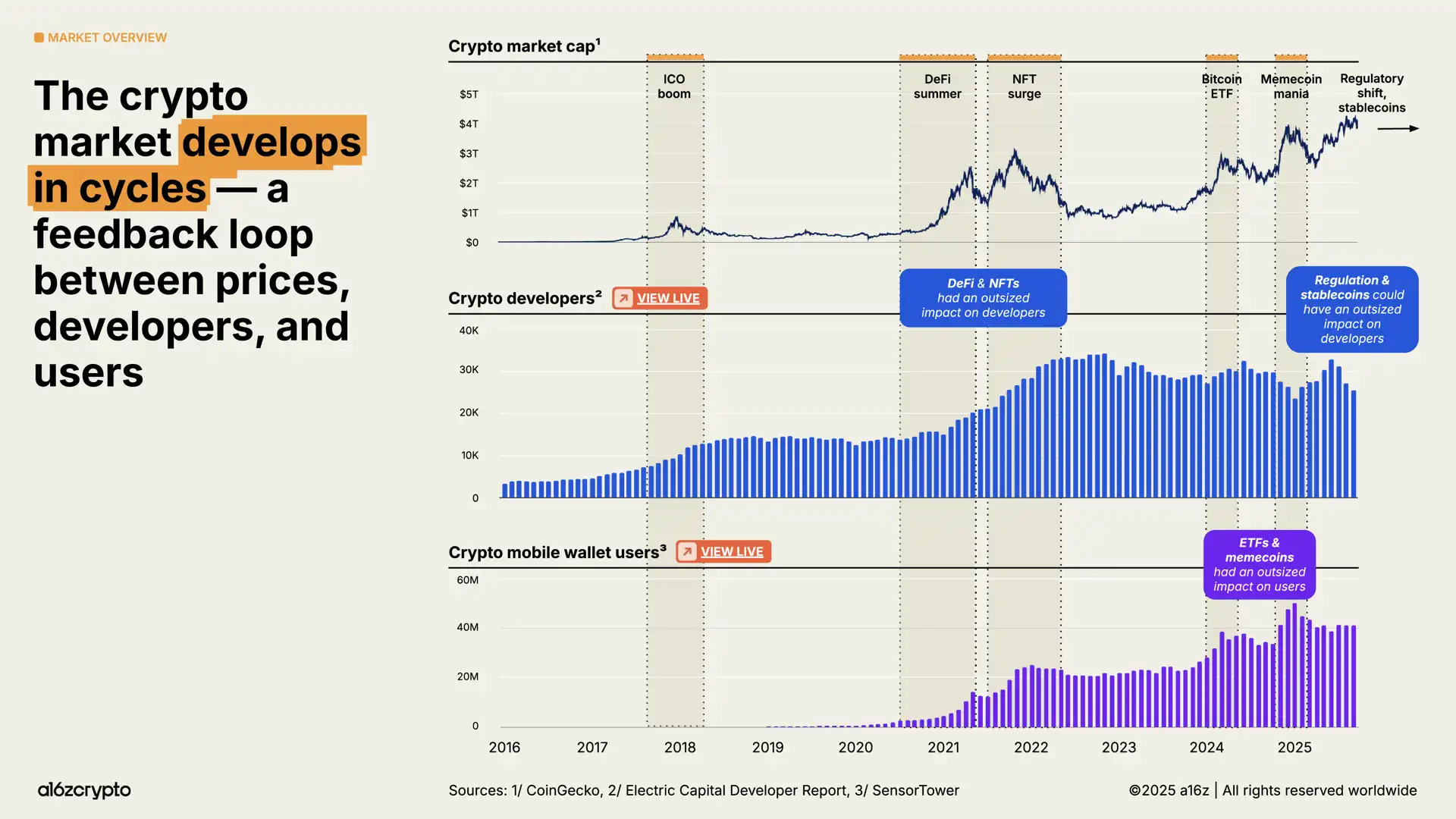
Based on our analysis using an updated methodology, the current global active crypto users are estimated to be around 40 to 70 million, an increase of about 10 million from last year.
This number represents only a small proportion of the 716 million crypto asset holders globally (a 16% increase year-on-year) and is also much lower than the approximately 181 million on-chain monthly active addresses (an 18% decrease year-on-year).
The difference in numbers between passive holders (those who own crypto assets but do not engage in on-chain transactions) and active users (those who regularly transact on-chain) reveals an important opportunity for crypto builders: how to reach the potential user base that already holds crypto assets but has not yet participated in on-chain activities.
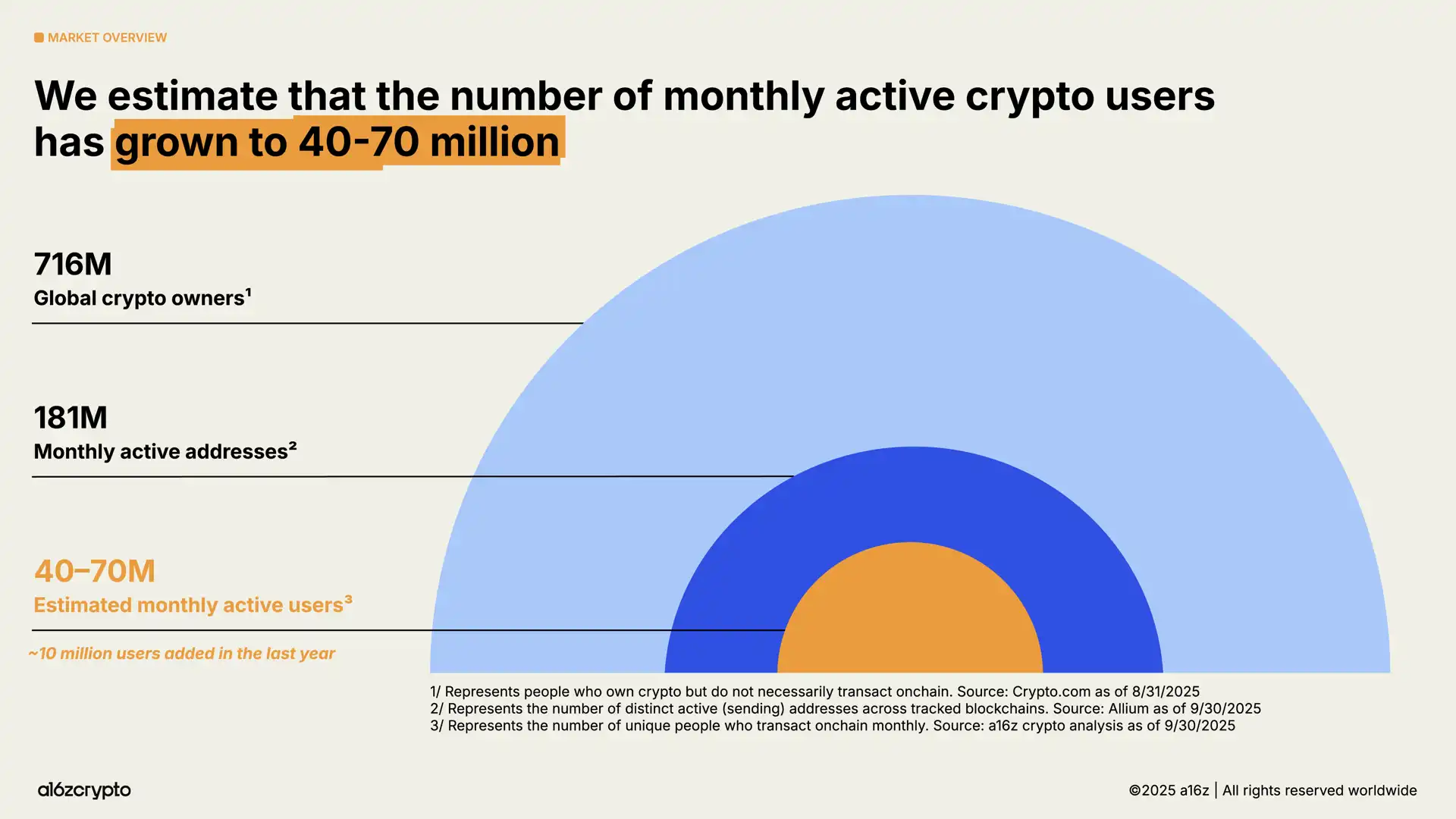
So, where are these crypto users distributed? What activities are they engaged in?
The crypto ecosystem has a global nature, but different regions exhibit differentiated usage patterns. The usage of mobile wallets, as an indicator of on-chain activities, is growing fastest in emerging markets such as Argentina, Colombia, India, and Nigeria (especially Argentina, where the use of crypto mobile wallets has increased 16-fold against the backdrop of a currency crisis intensifying over the past three years).
Meanwhile, our analysis of the geographical sources of token-related network traffic shows that the token interest index leans more toward developed countries. Compared to user behavior in developing countries, activities in countries like Australia and South Korea may be more concentrated in trading and speculation.
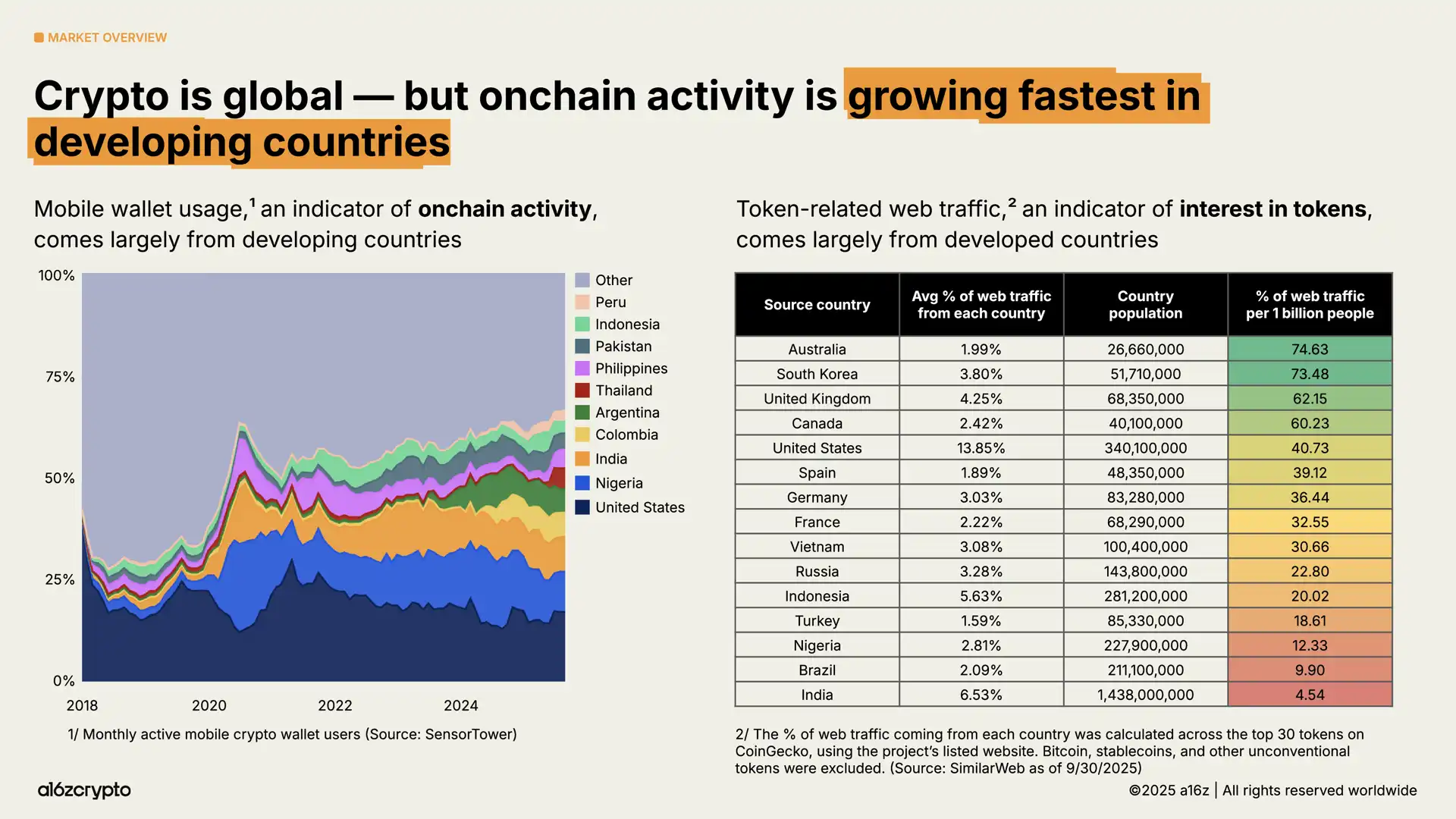
Bitcoin (still accounting for over half of the total cryptocurrency market value) has been favored by investors as a store of value, reaching a historic high of over $126,000. Meanwhile, Ethereum and Solana have recaptured most of their lost ground following the 2022 crash.
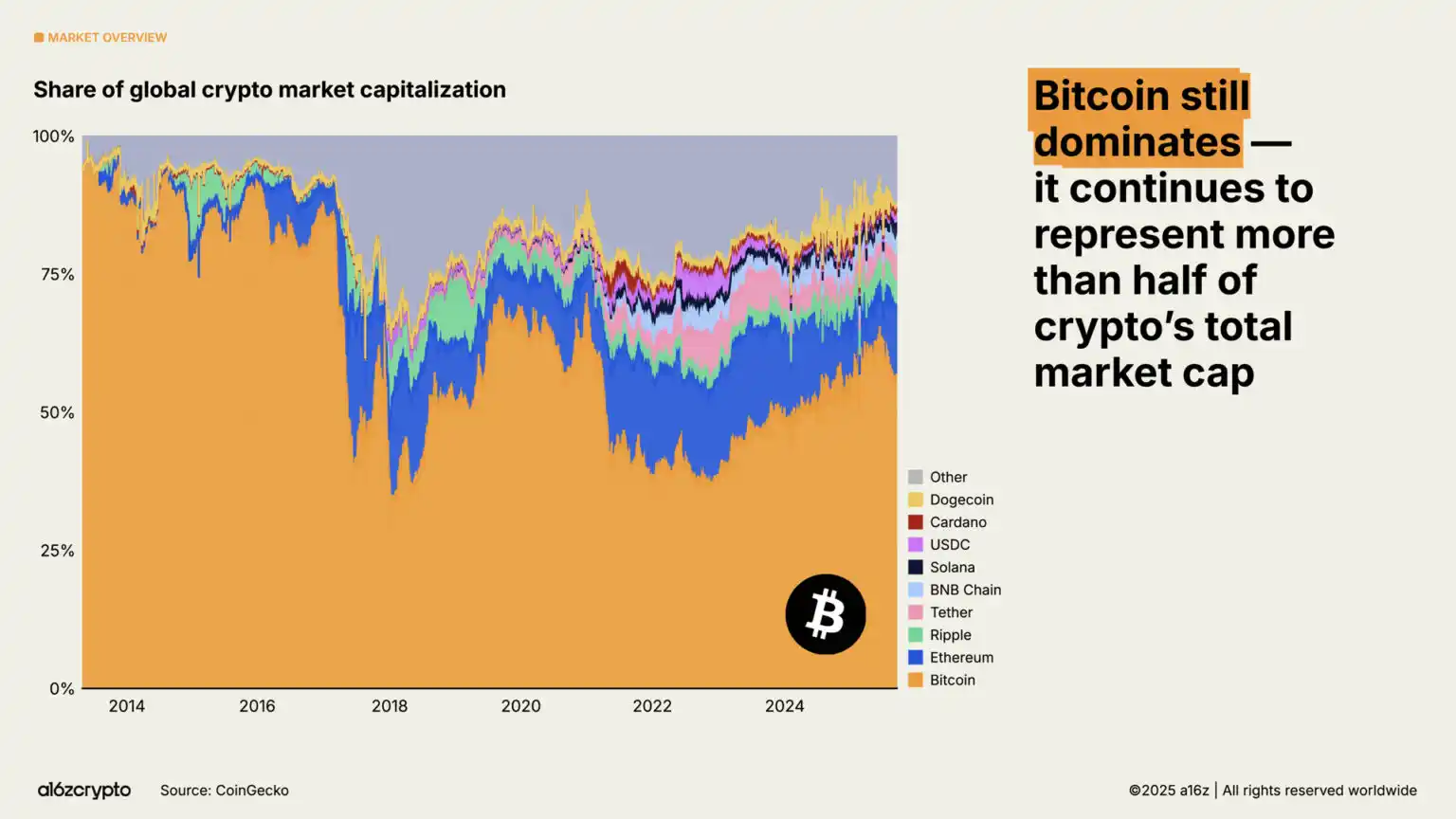
As blockchain continues to scale, the fee market matures, and new applications emerge, certain metrics are becoming increasingly important. One of these is "real economic value" – measuring the actual scale of fees users pay to use the blockchain. Currently, Hyperliquid and Solana account for 53% of revenue-generating economic activity, marking a significant shift from the previous dominance of Bitcoin and Ethereum.
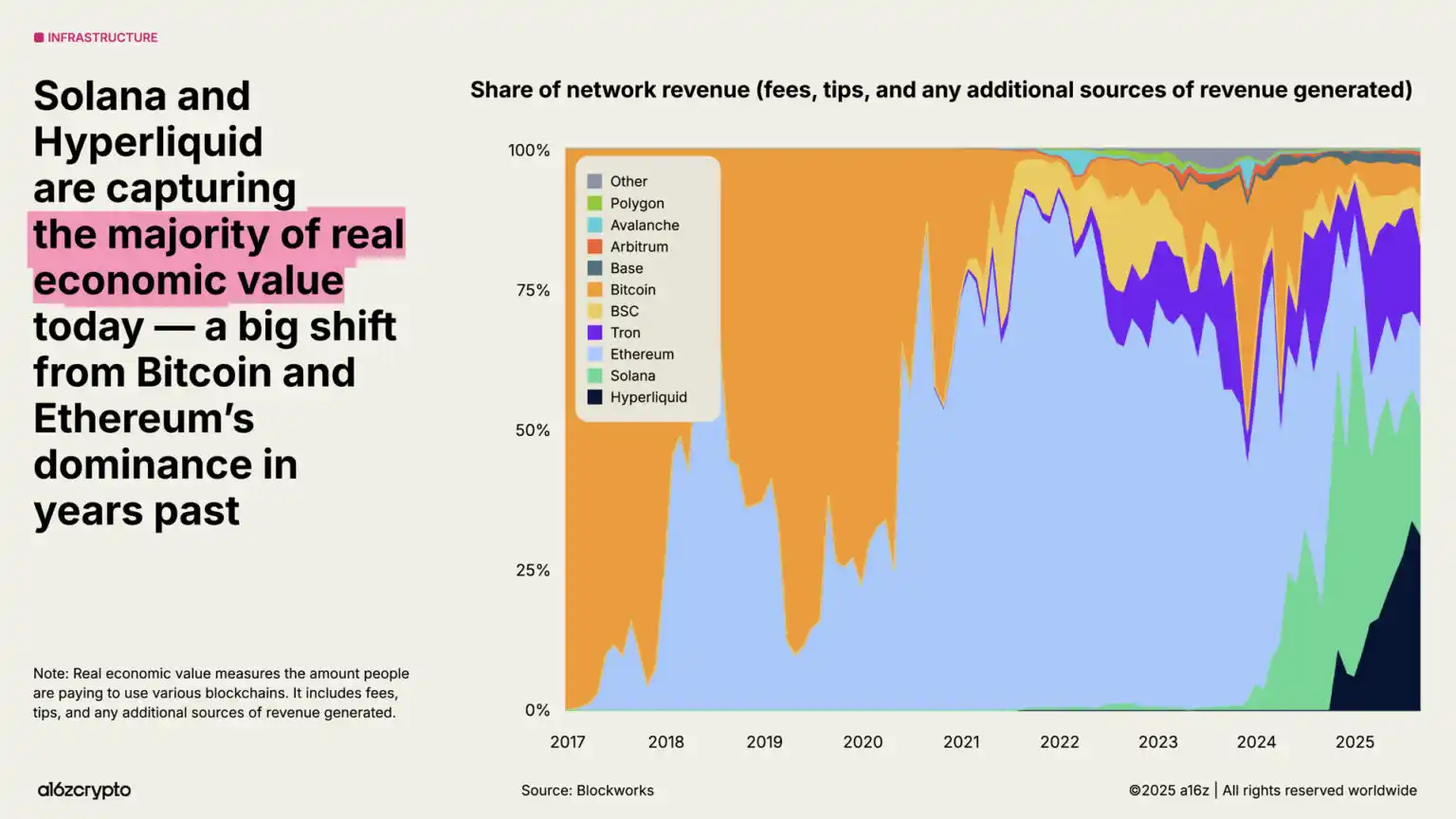
From the developer ecosystem perspective, the crypto world still exhibits a multi-chain landscape, with Bitcoin, Ethereum and its layer 2 networks, and Solana forming the three core developer hubs. By 2025, Ethereum and its layer 2 networks have become the top choice for new developers, while Solana is one of the fastest-growing ecosystems – with developer interest increasing by 78% over the past two years. This data is derived from analysis by the a16z crypto investment team on entrepreneurs' preferred development platforms.
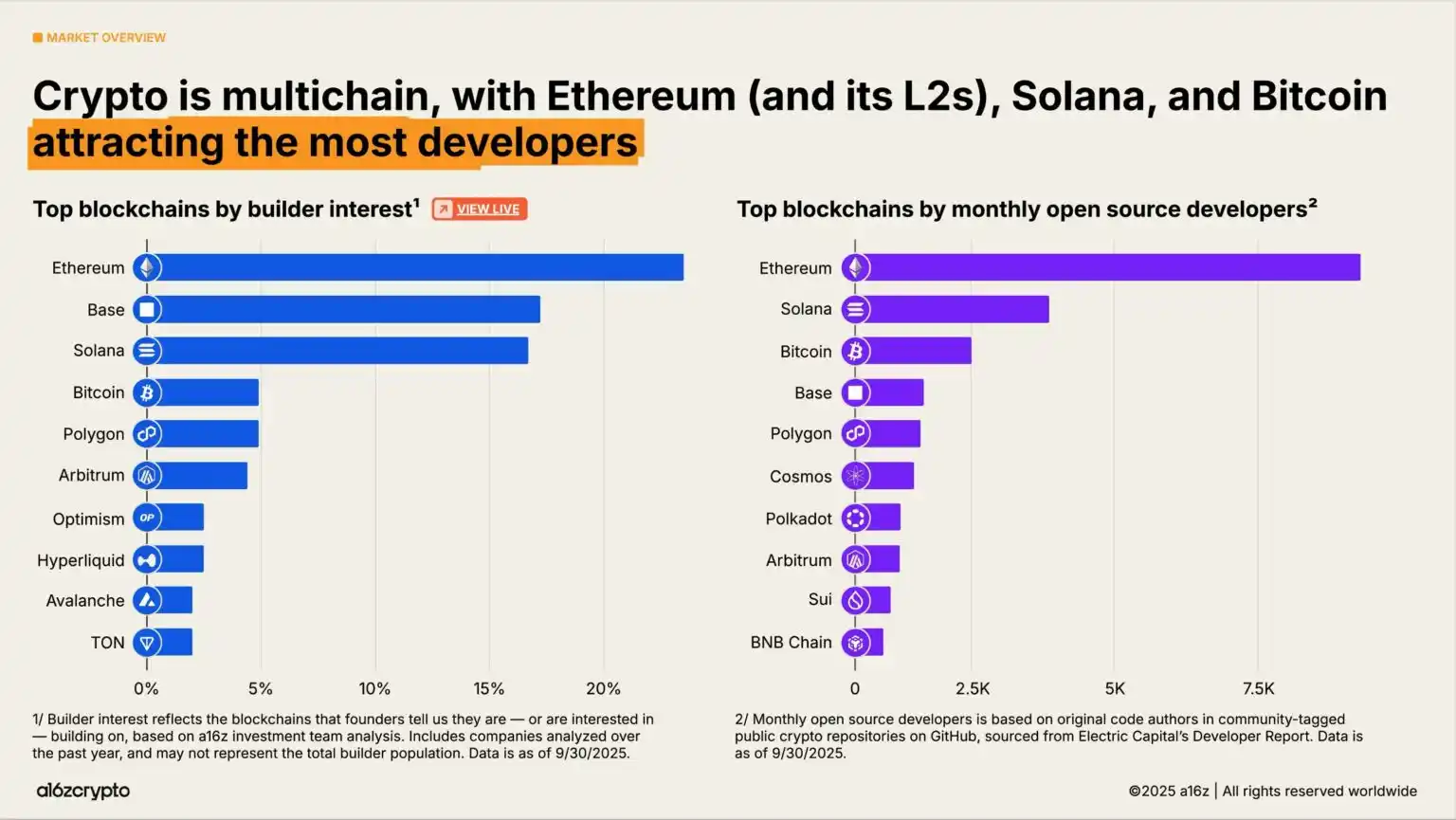
2. Financial Institutions Fully Embrace Cryptocurrency Assets
2025 can be described as the year of institutional adoption. Following last year's "Cryptocurrency Industry Landscape" report, which declared stablecoins achieved product-market fit in just five days, Stripe announced the acquisition of the stablecoin infrastructure platform Bridge, kicking off the traditional financial companies' public positioning in the stablecoin space.
Months later, Circle's multibillion-dollar IPO marked stablecoin issuers officially entering the mainstream financial institution realm. Subsequently, in July, the bipartisan-supported "GENIUS Act" was formally legislated, providing clear action guidance for builders and institutions. The frequency of stablecoin mentions in SEC filings grew by 64%, and announcements of strategic moves by major financial institutions surged.
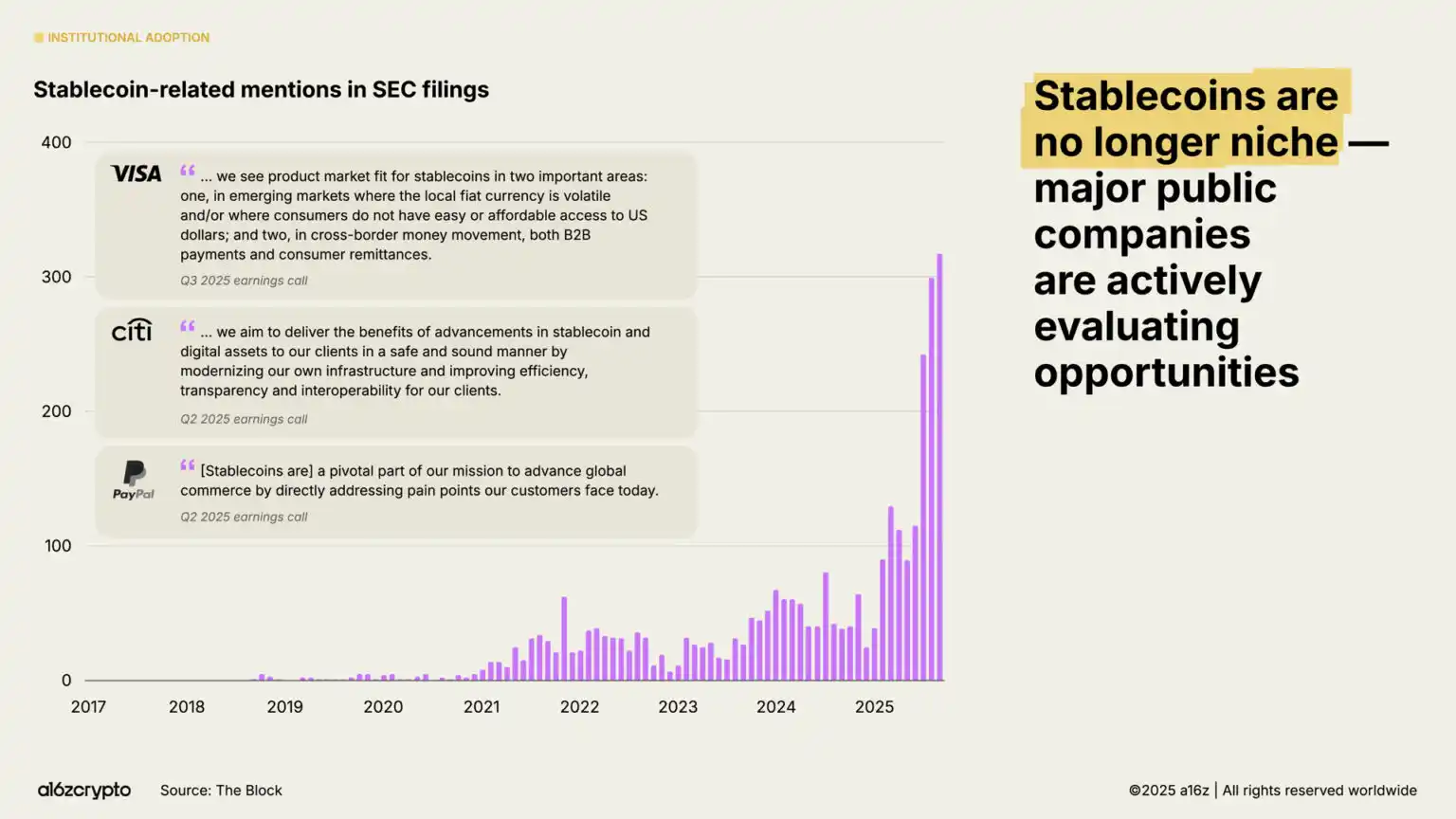
Institutional adoption is gaining momentum. Traditional financial institutions such as Citigroup, Fidelity, JPMorgan Chase, Mastercard, Morgan Stanley, and Visa have started (or are planning) to directly offer crypto products to consumers, enabling them to buy, sell, and hold digital assets as well as stocks, exchange-traded products, and other traditional instruments. Meanwhile, platforms like PayPal and Shopify are doubling down on the payment space, building infrastructure for everyday transactions between merchants and consumers.
Aside from direct product offerings, major fintech companies like Circle, Robinhood, and Stripe are actively developing or have announced plans to develop new blockchains focused on payments, real-world assets, and stablecoins. These initiatives may drive more payment flows onto the blockchain, promote enterprise adoption, and ultimately build a larger, faster, more globalized financial system.
These companies possess vast distribution networks. With continued development, cryptographic technology is poised to be fully integrated into the financial services we use in our daily lives.
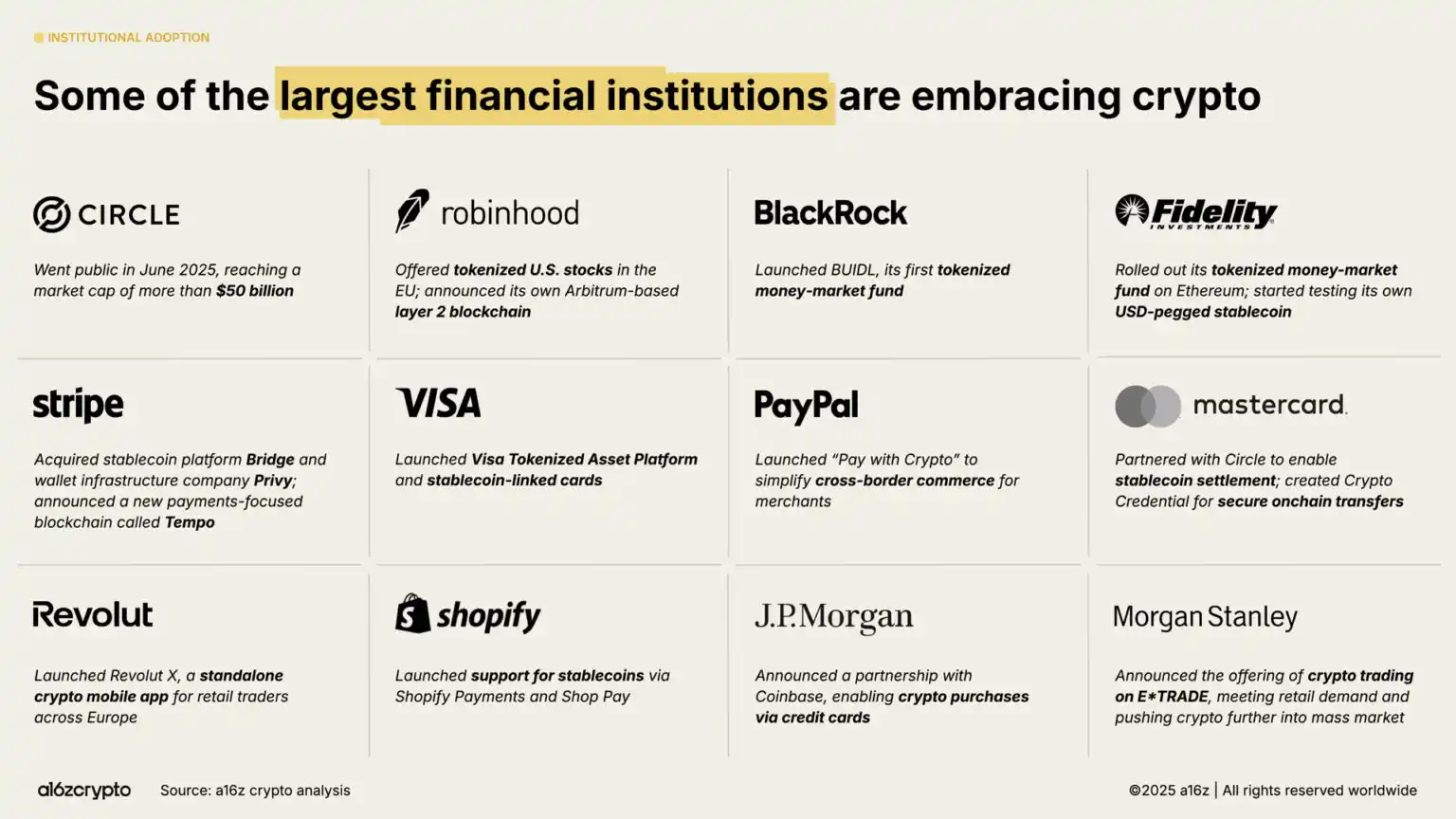
Exchange-traded products have become another key driver of institutional investment, with the current on-chain crypto asset holdings surpassing $175 billion, a 169% surge from $65 billion a year ago.
BlackRock's iShares Bitcoin Trust is hailed as the most actively traded bitcoin exchange-traded product in history, and the recently launched Ethereum exchange-traded product has also seen significant inflows in recent months. (Note: Although commonly referred to as exchange-traded funds, these products are actually filed under an S-1 registration with the SEC as exchange-traded products, indicating that their underlying assets do not include securities.)
These products have significantly lowered the investment barrier for crypto assets, opening up an entry point for institutional capital that has historically remained on the industry's periphery.
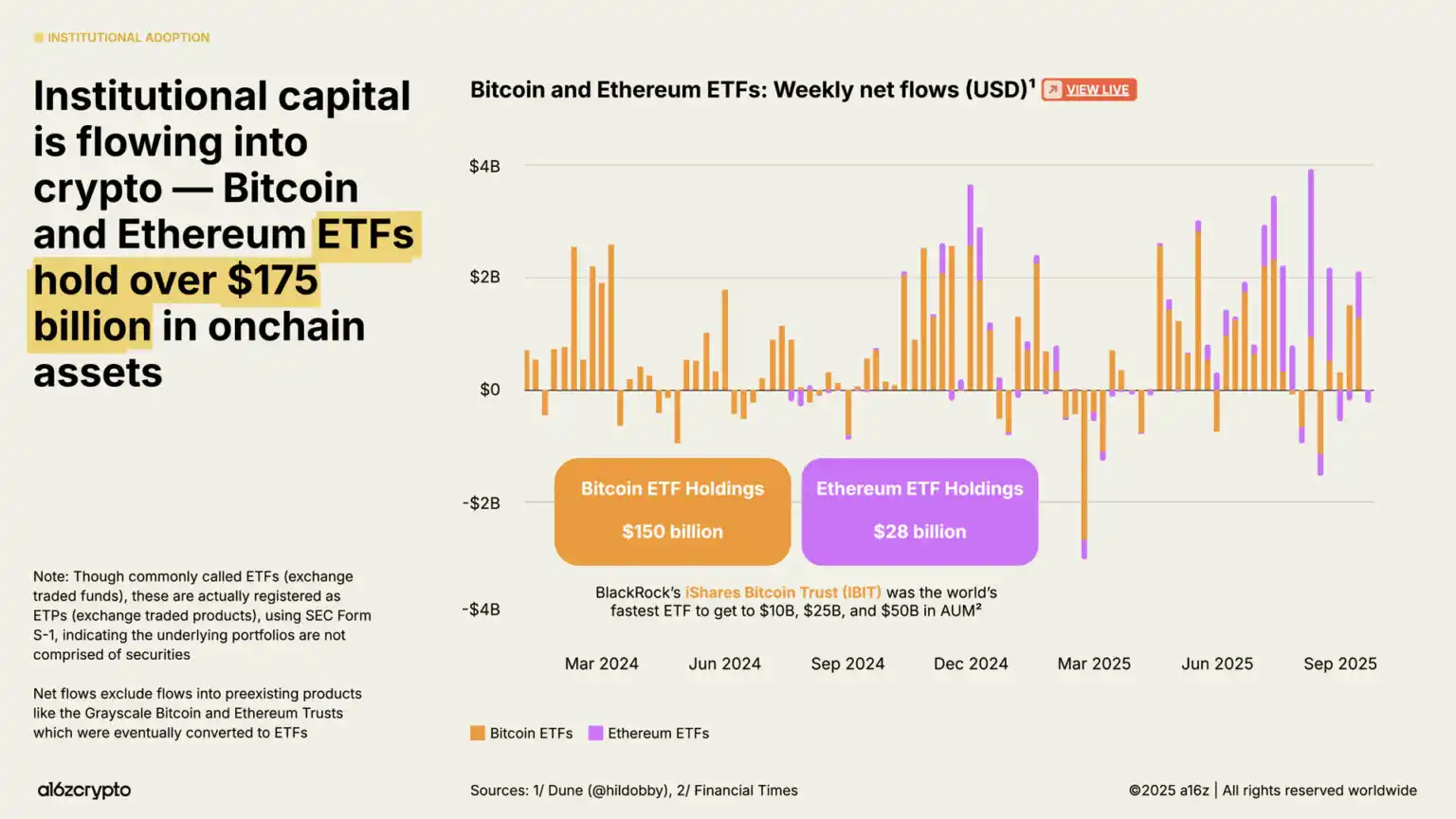
Publicly traded "digital asset reserve" companies—entities that hold crypto assets on their balance sheets (similar to a corporate treasury holding cash)—currently collectively hold approximately 4% of the circulating supply of Bitcoin and Ethereum. These digital asset reserve companies, combined with exchange-traded products, now hold around 10% of the circulating supply of Bitcoin and Ethereum.
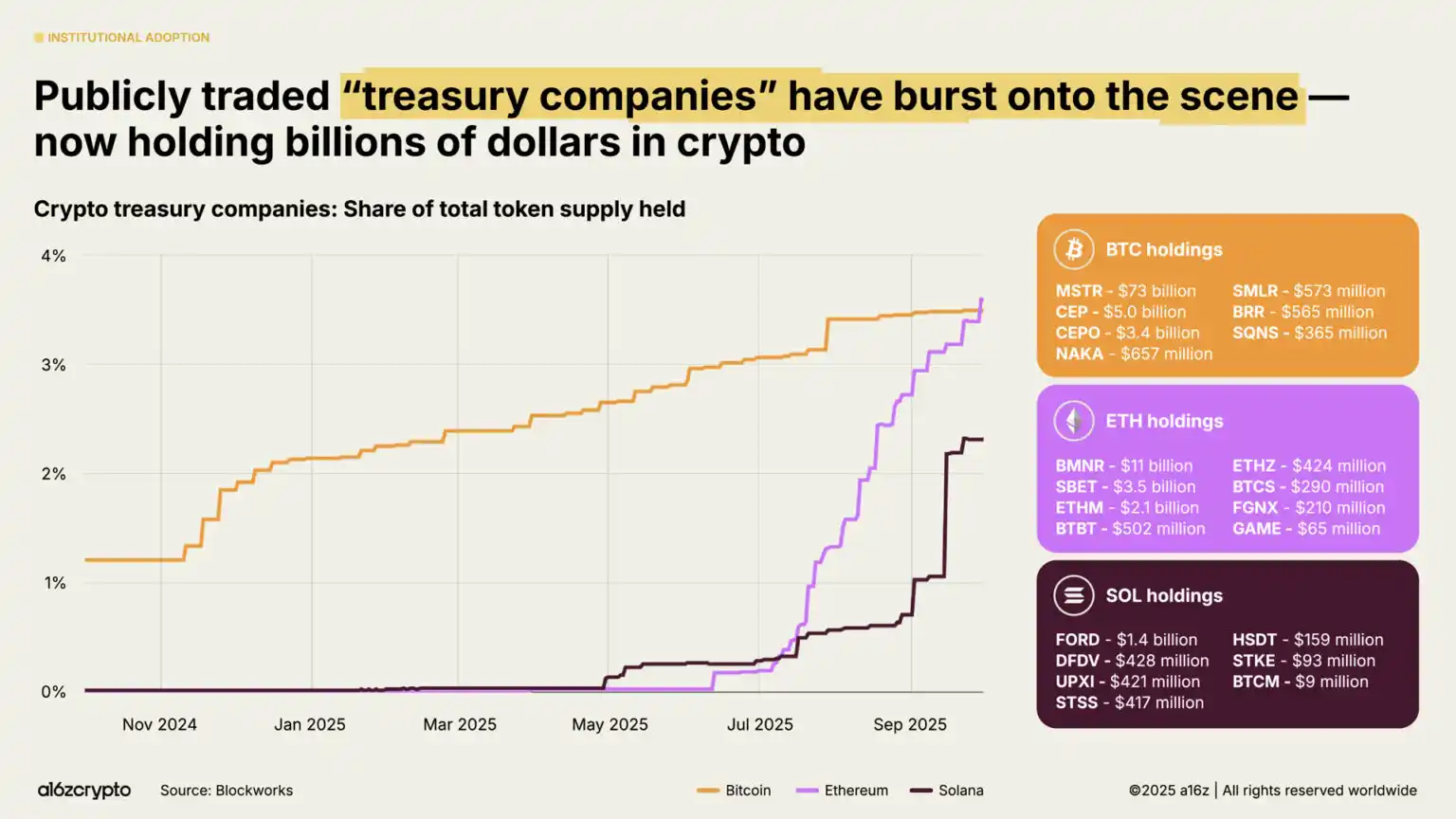
3. Mainstreaming of Stablecoins
The most significant sign of the maturity of the crypto market in 2025 is undoubtedly the rise of stablecoins. In previous years, stablecoins were mainly used for settling speculative crypto trades, but in the last two years, they have become the fastest and cheapest way for global transfers in USD — processing millions of transactions per second, with a cost of less than one cent per transaction, covering the vast majority of regions globally.
This year, stablecoins have become a cornerstone of the on-chain economy.
Over the past year, the total stablecoin transaction volume reached $46 trillion, a 106% year-on-year increase. While this mainly represents fund flows (unlike retail payments through card networks), the scale has now reached three times that of Visa and is nearing the ACH network that spans the entire US banking system.
When adjusted (excluding bot and artificially inflated transaction data), the real stablecoin transaction volume over the past 12 months was $9 trillion, an 87% year-on-year growth, which is over five times PayPal's volume and surpasses half of Visa's scale.
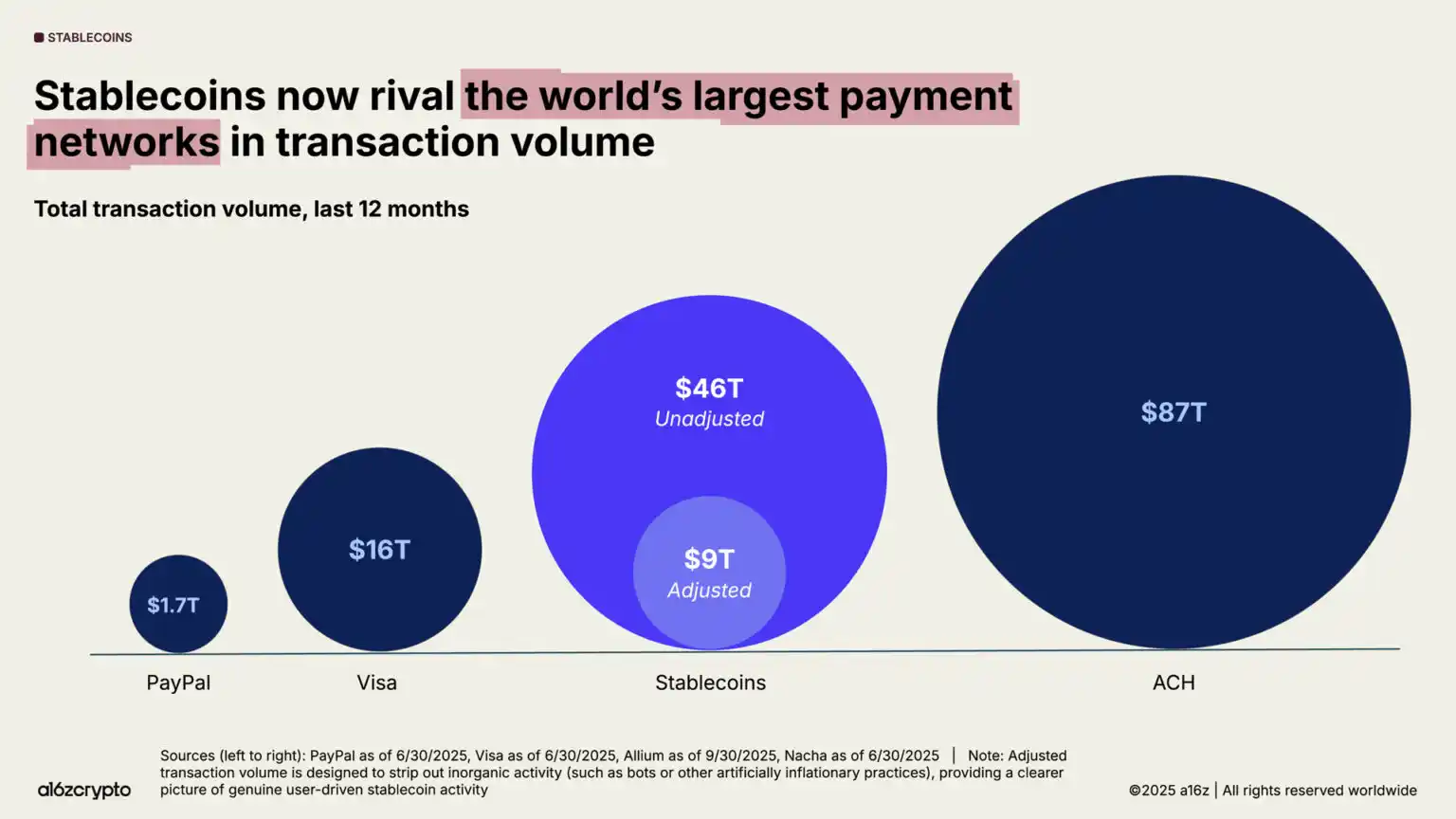
Adoption is accelerating. The adjusted monthly stablecoin transaction volume has surged to a historic high, with nearly $1.25 trillion just in September 2025.
Of note, this activity has a relatively low correlation with the overall crypto trading volume — indicating that stablecoins are being used for non-speculative purposes. More importantly, this confirms the alignment of its product with the market.
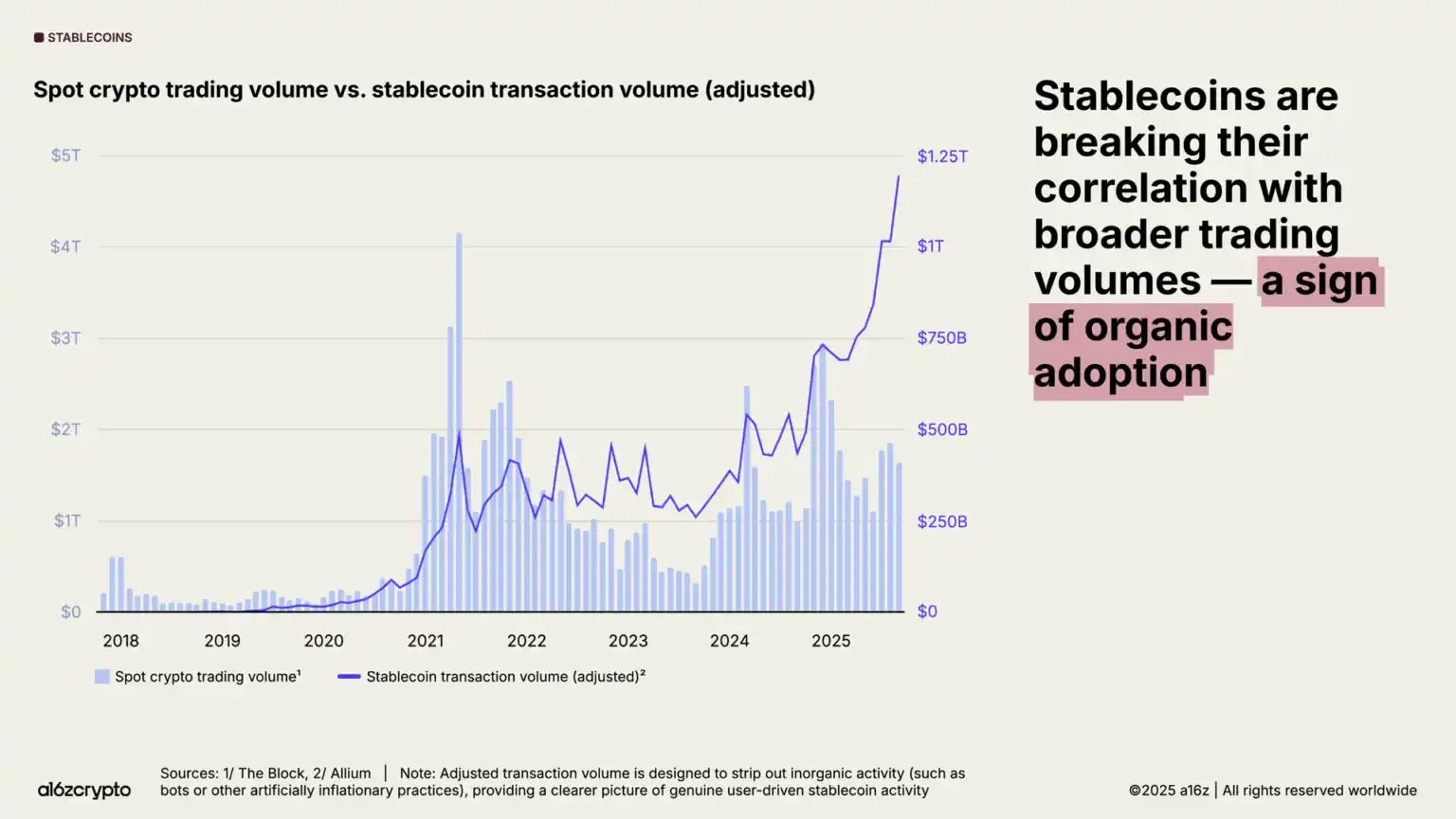
The total stablecoin supply has also reached a historic high, now exceeding $300 billion.
The market is dominated by leading stablecoins: Tether and USDC account for 87% of the total supply. In September 2025, the stablecoin transaction volume processed on the Ethereum and Tron blockchains (when adjusted) reached $772 billion, representing 64% of all transaction volume. While these two major issuers and blockchains hold the lion's share of stablecoin activity, the momentum of growth for emerging blockchains and issuers is also accelerating.
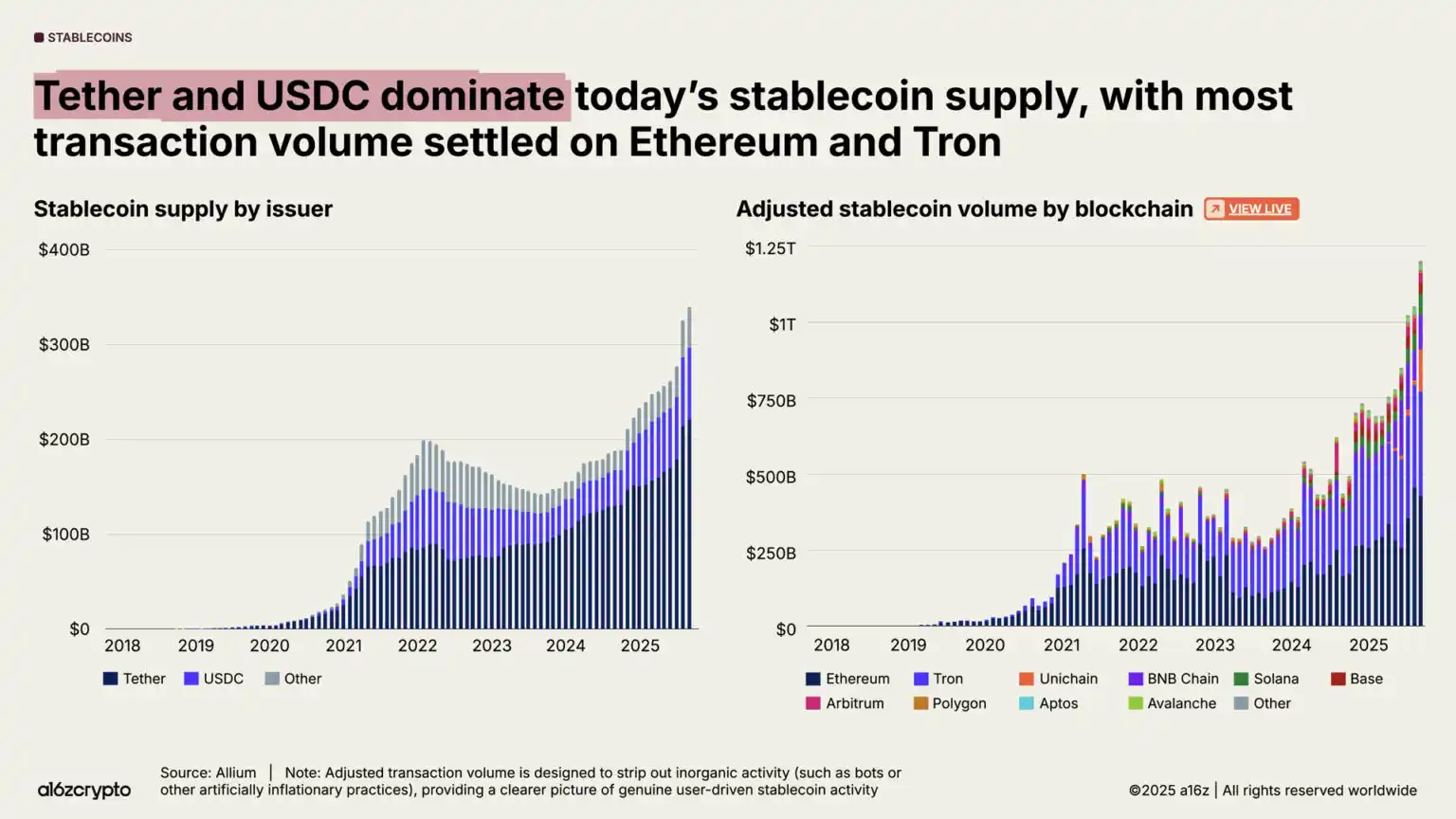
Stablecoins have become a significant force in the global macroeconomy: over 1% of the USD exists in tokenized stablecoin form on public blockchains, and their holdings of US Treasury bonds have risen from 20th place last year to 17th place. Currently, stable coins collectively hold over $150 billion in US Treasuries — surpassing the holdings of many sovereign nations.
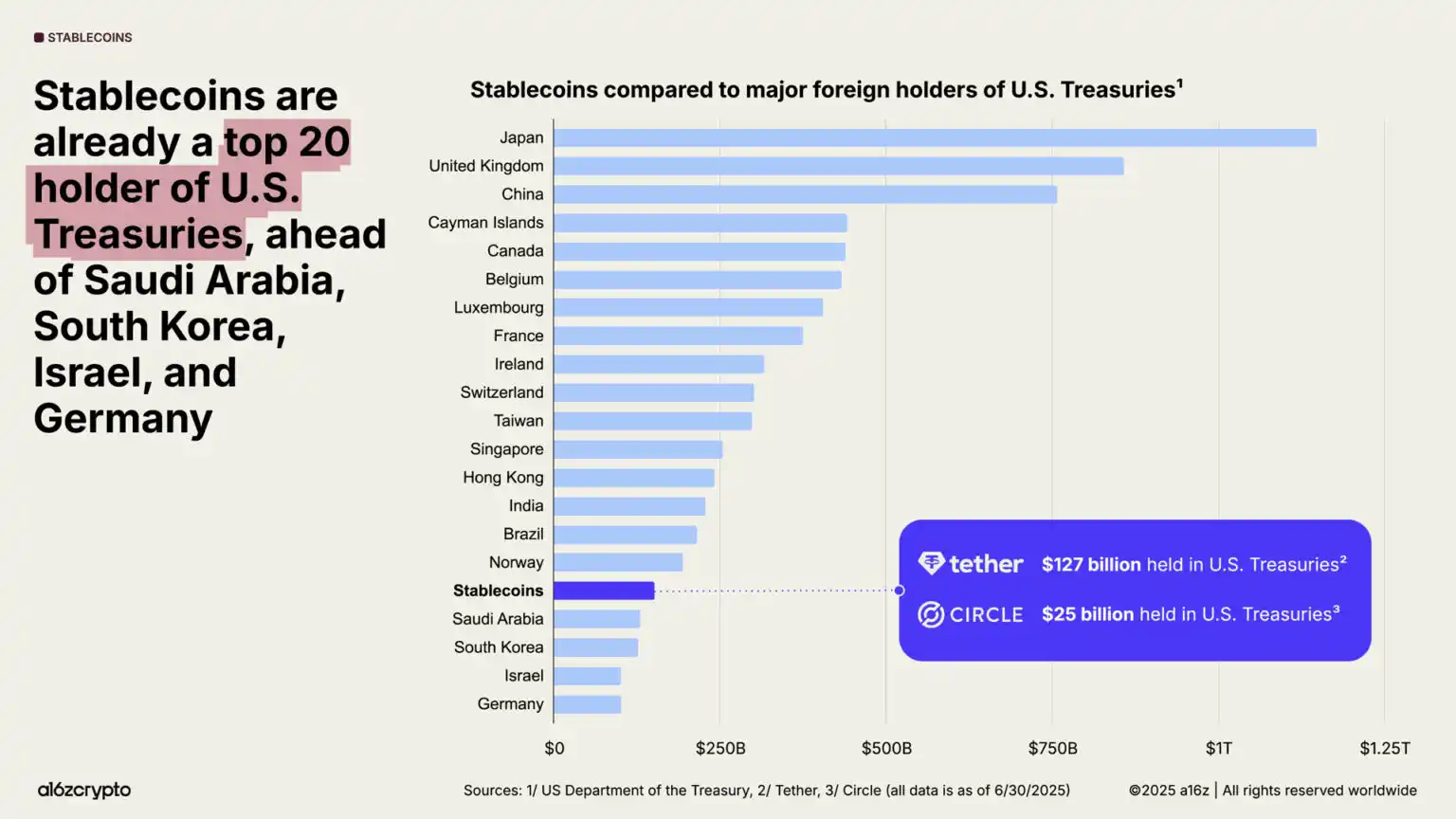
Meanwhile, despite a weakening global demand for U.S. Treasuries, its national debt continues to soar. For the first time in 30 years, foreign central banks' gold reserves have exceeded U.S. Treasury holdings.
However, stablecoins are on the rise: over 99% of stablecoins are dollar-denominated, and their market is expected to grow more than tenfold to over $30 trillion by 2030. This could potentially provide a robust and sustainable source of demand for U.S. debt in the coming years.
Even as foreign central banks reduce their holdings of U.S. debt, stablecoins are solidifying the dollar's dominance.
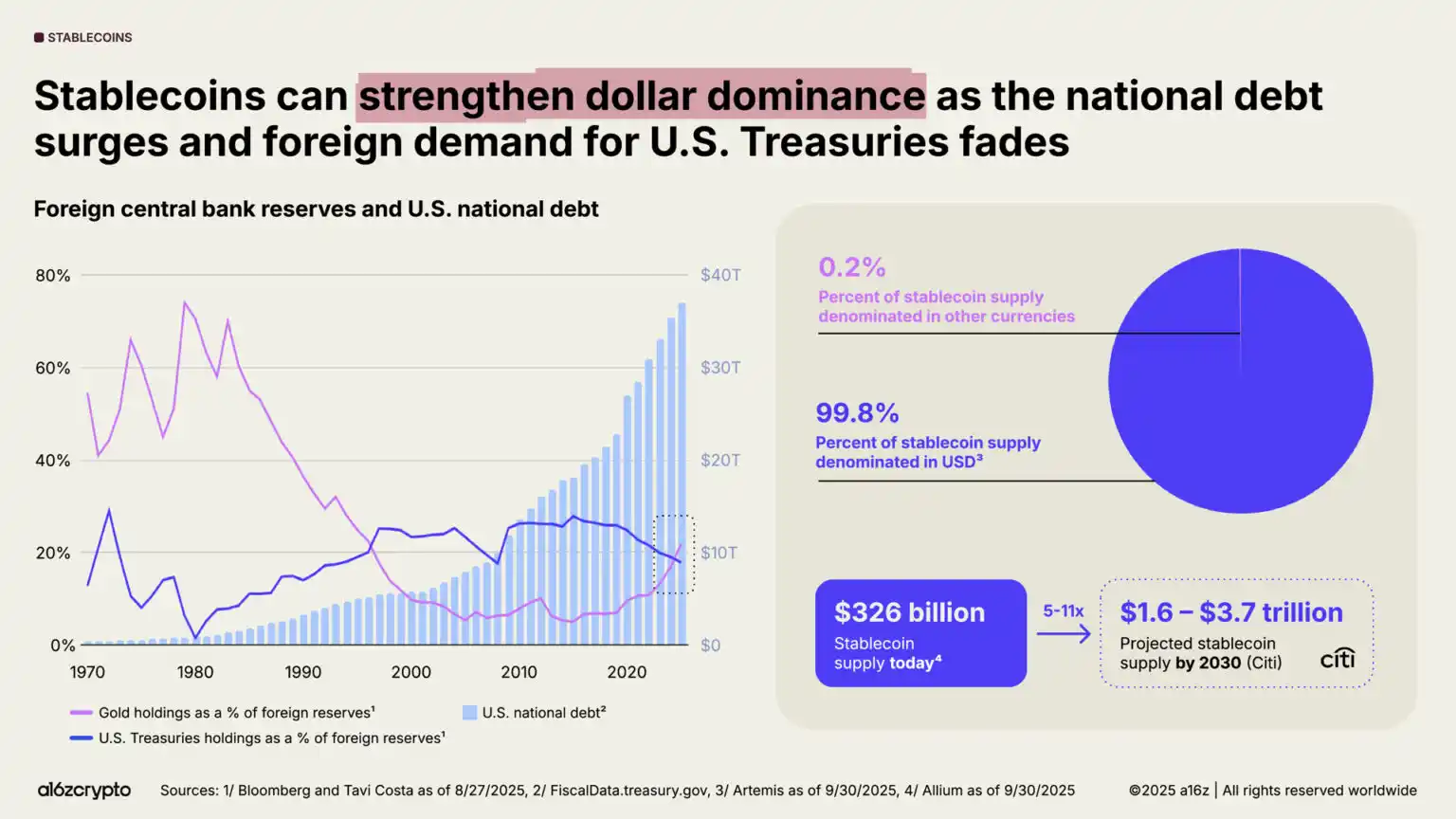
4. Resilience of the U.S. Cryptocurrency Ecosystem Reaches an All-Time High
The U.S. has reversed its previous hostile stance towards the cryptocurrency sector, revitalizing builder confidence.
This year, the passage of the "GENIUS Act" and approval of the "CLARITY Act" by the House of Representatives signal a bipartisan consensus that cryptocurrency assets will not only survive in the U.S., but also have the conditions for prosperous development. These two acts together establish a stablecoin regulatory framework that balances innovation and investor protection, market structure, and digital asset supervision. Meanwhile, Executive Order 14178 revokes previous anti-crypto directives and establishes an inter-agency working group to drive the modernization of federal digital asset policy.
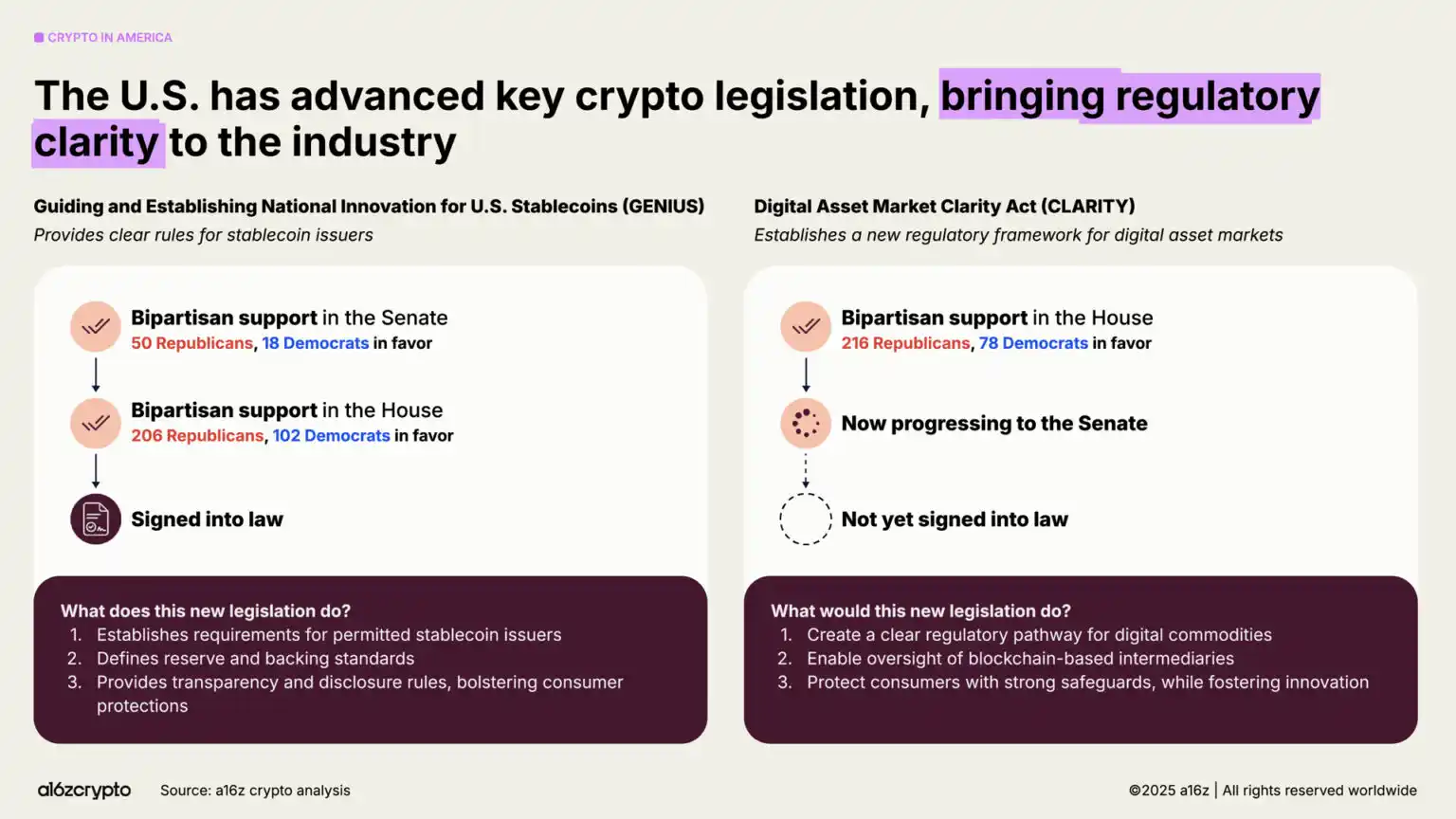
The regulatory environment is paving the way for builders to fully unleash the potential of tokens as a new digital lingua franca, much like the significance of websites to earlier generations of the internet. With a clearer regulatory framework, more network tokens will complete the economic loop by generating returns for holders, thus creating a new economic engine for the internet that is self-sustaining and allows more users to share in the system's rewards.
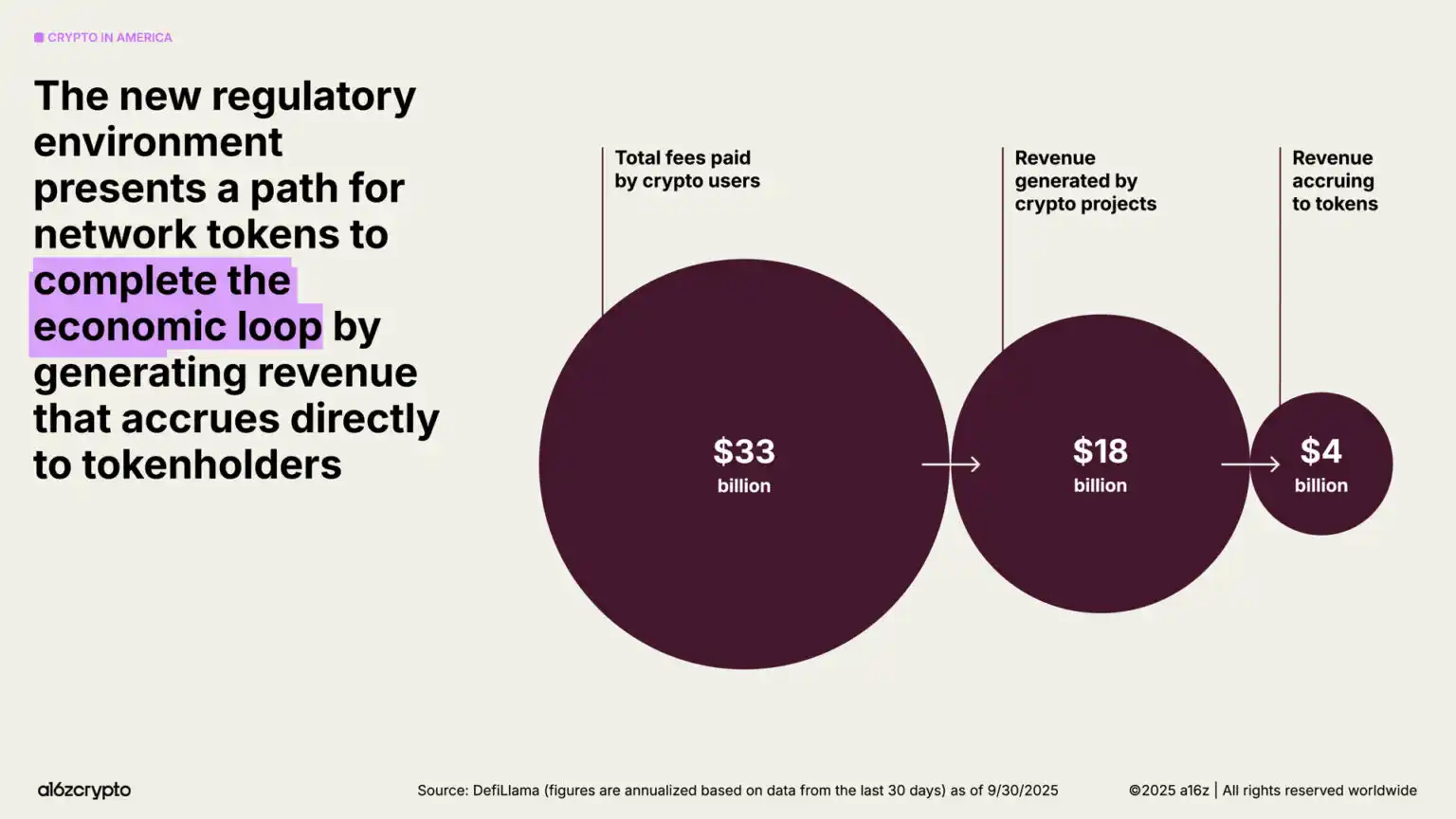
5. Global Acceleration of On-Chain Transformation
What was once a niche experimental ground for early adopters, the on-chain economy has evolved into a diverse ecosystem with tens of millions of monthly active participants. Today, nearly one-fifth of spot trading volume is conducted through decentralized exchange platforms.
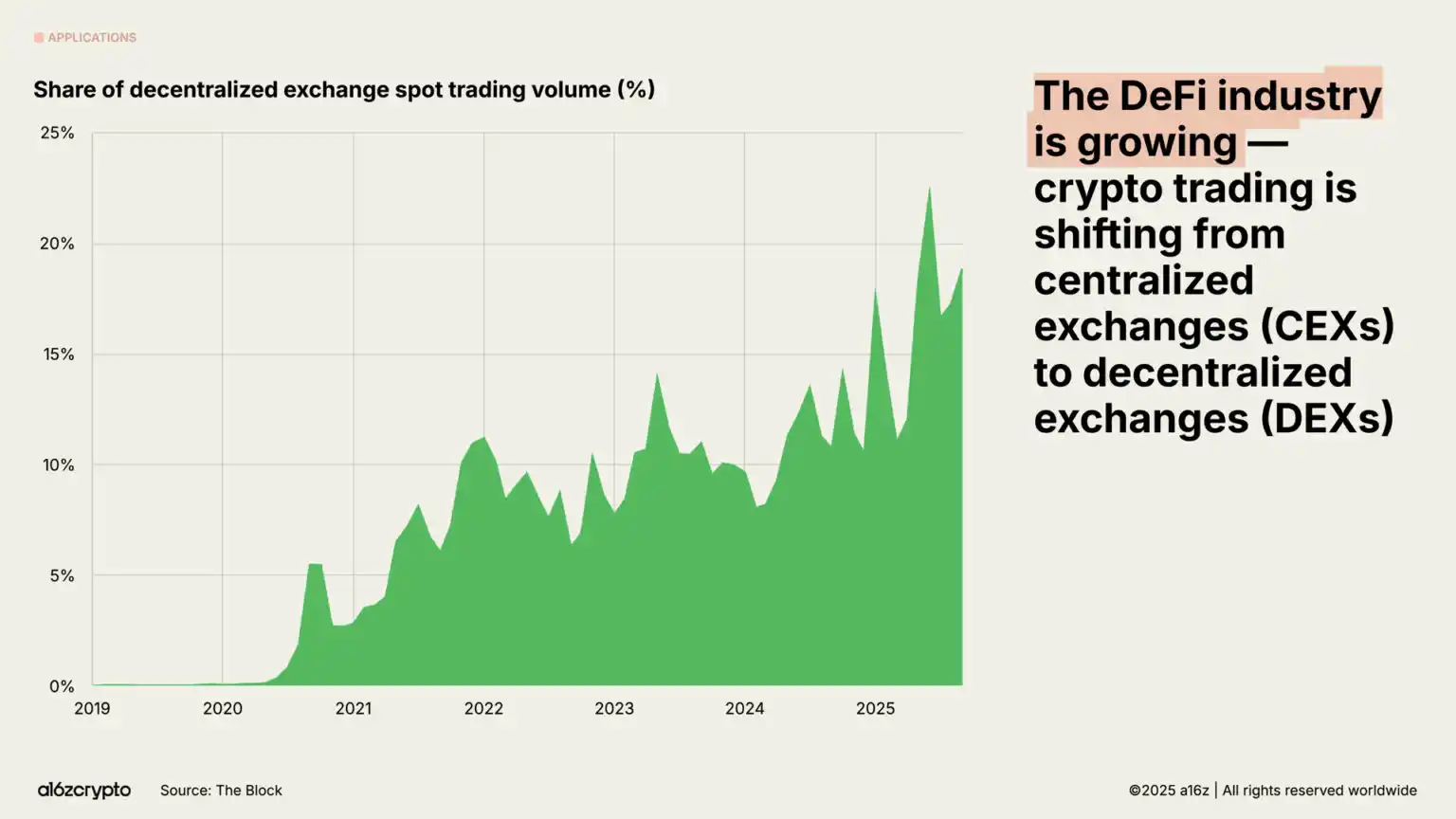
The trading volume of perpetual contracts has surged nearly 8x in the past year, experiencing explosive growth among cryptocurrency speculators. Decentralized perpetual contract trading platforms such as Hyperliquid have processed trillions of dollars in trading volume, generating over $1 billion in annualized revenue this year—data that is now comparable to some centralized exchanges.
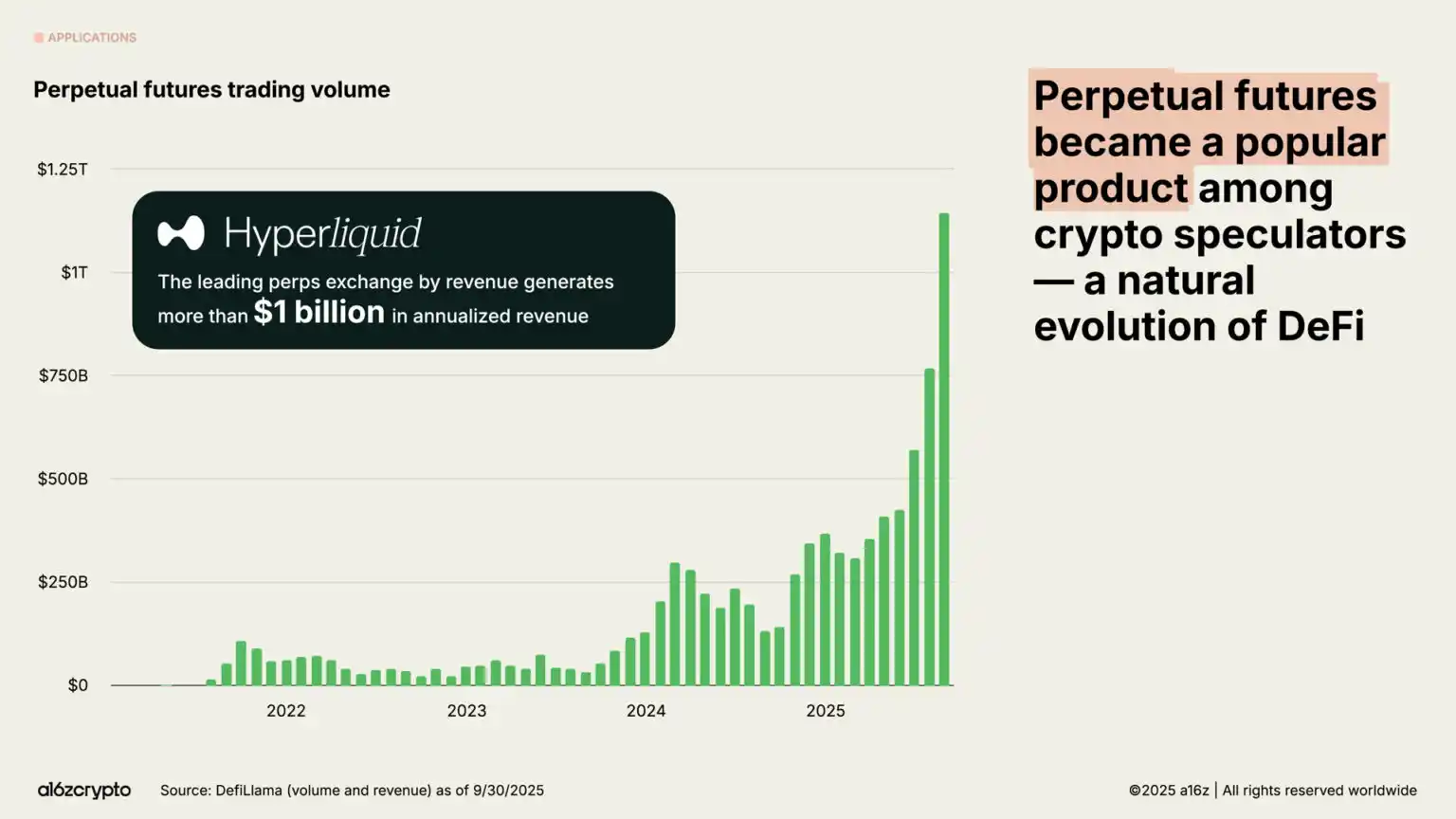
Real-world assets—including U.S. Treasuries, money market funds, private credit, and real estate tokenized as traditional assets on-chain—are bridging the gap between crypto and traditional finance. The total market size of tokenized RWAs has reached $30 billion, nearly quadrupling over the past two years.
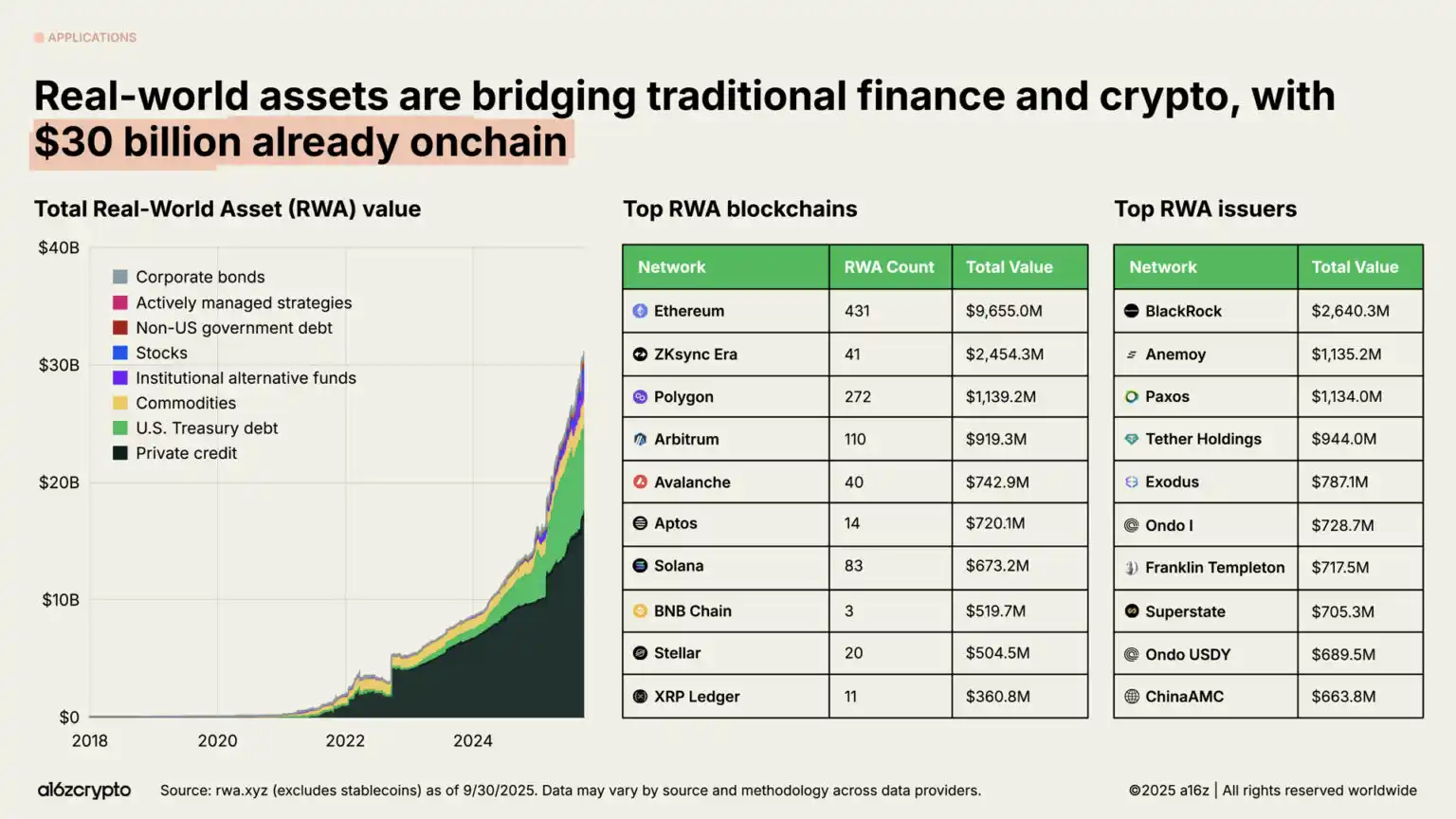
Outside the financial sector, the most ambitious frontier of blockchain by 2025 lies in DePIN—decentralized Physical Infrastructure Network.
Just as DeFi is restructuring the financial system, DePIN is reshaping physical infrastructure such as telecom networks, transportation systems, and energy grids. This field holds immense potential: the World Economic Forum predicts the DePIN market size will reach $35 trillion by 2028.
The Helium network serves as the most representative case. This grassroots-driven wireless network, operated by over 111,000 users through hotspots, currently provides 5G cellular coverage to 1.4 million daily active users.
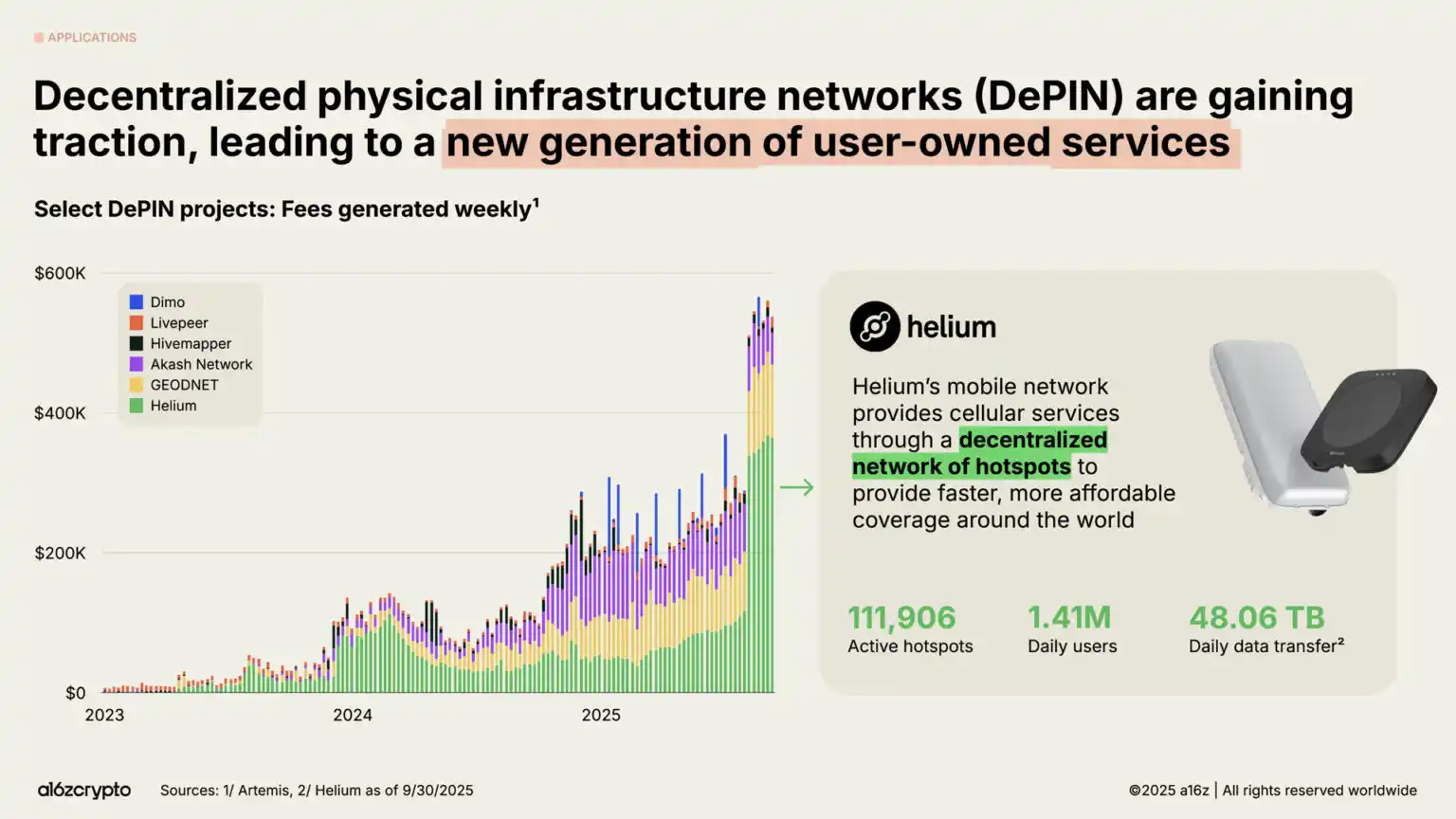
In 2024, the prediction market is set to break into the mainstream during the U.S. presidential election cycle, with leading platforms such as Polymarket and Kalshi seeing monthly trading volumes in the billions of dollars. Despite past doubts about "maintaining activity in non-election years," these platforms have seen nearly a 5x increase in trading volume since early 2025, approaching historical highs.
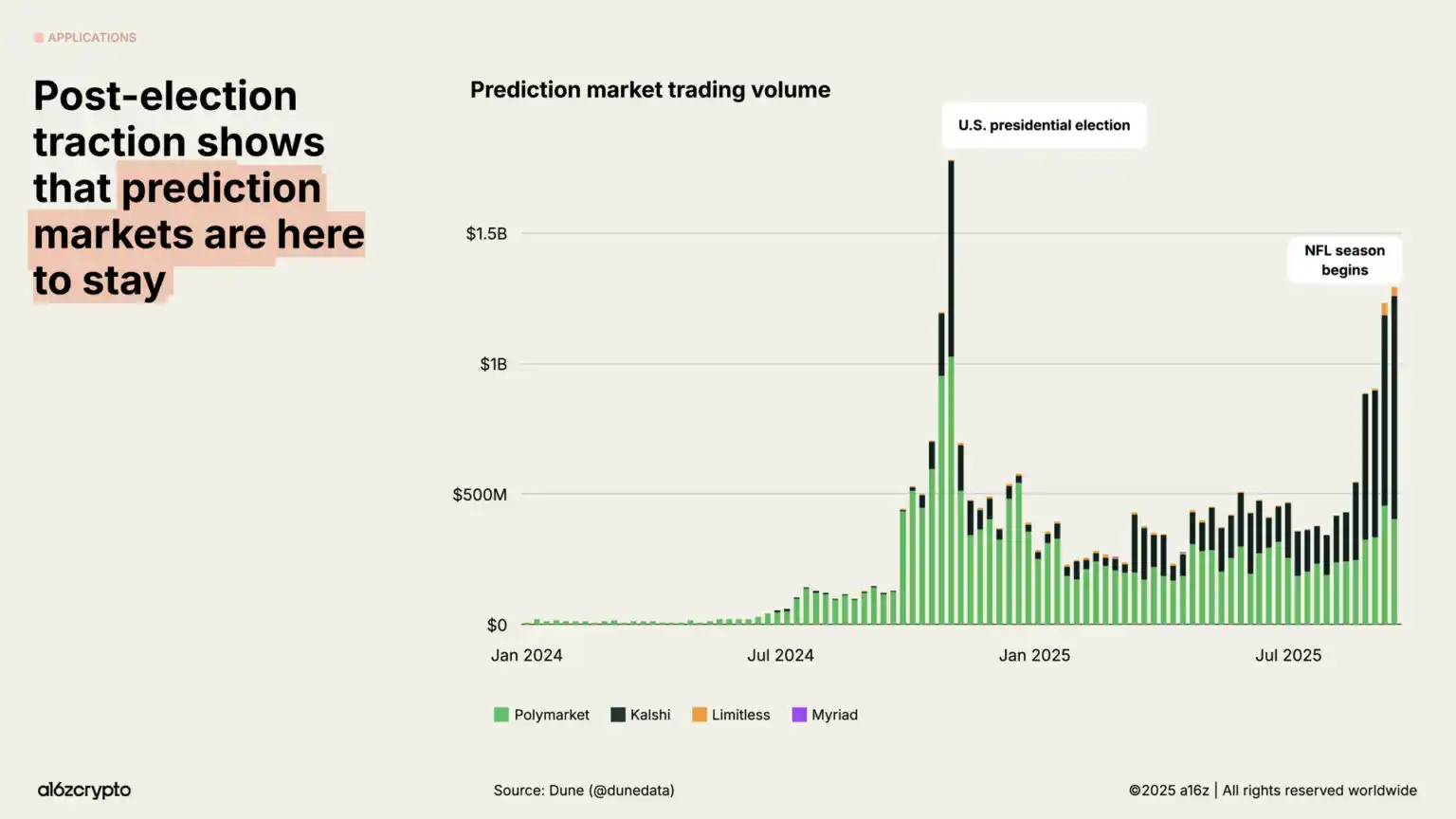
In an environment lacking clear regulation, Memecoins have experienced explosive growth, with over 13 million varieties emerging in the past year. As benign policies and bipartisan legislation clear the way for more constructive blockchain use cases, this trend has cooled off in recent months—September issuance has dropped by 56% compared to January.
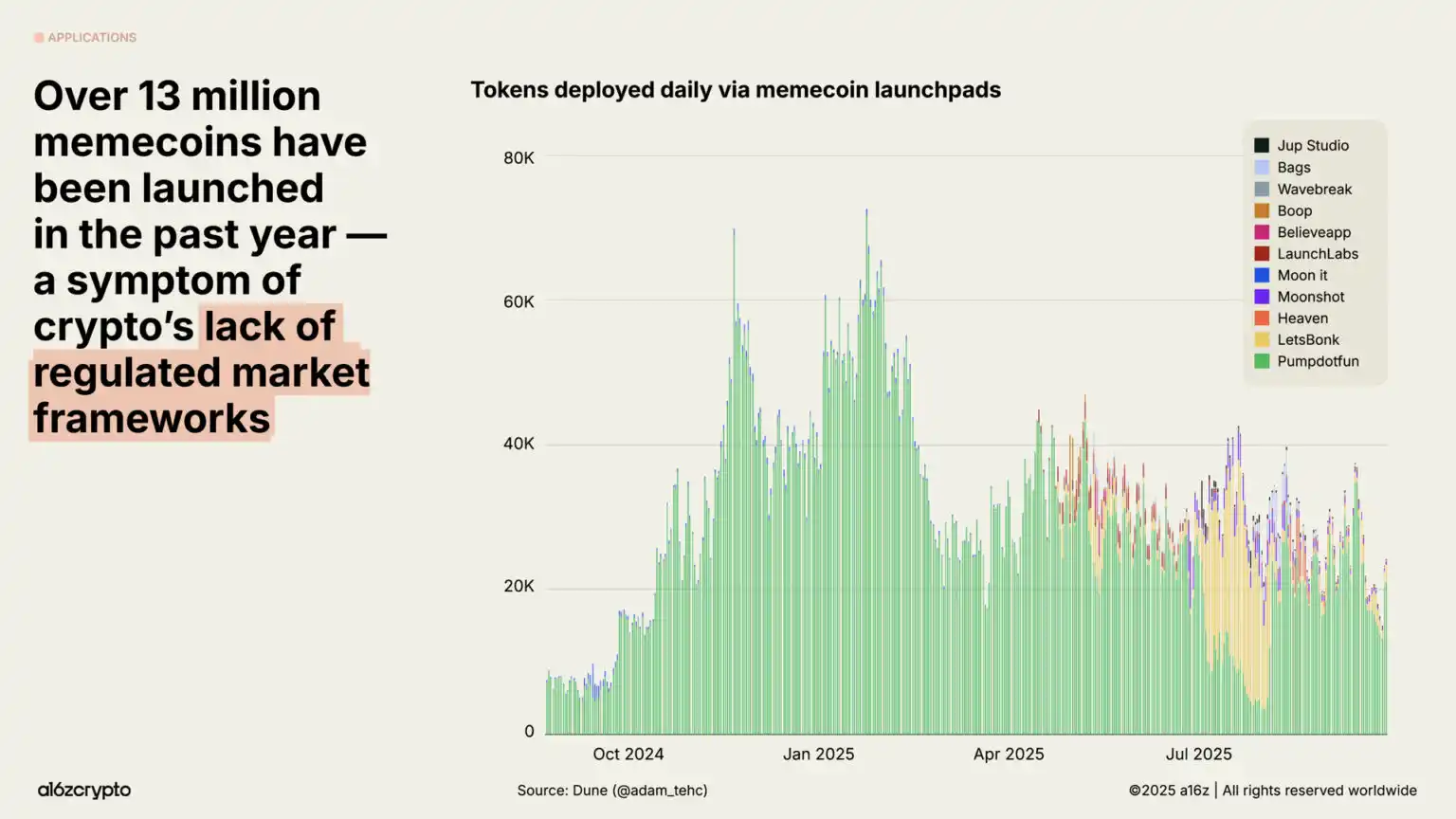
Although the NFT market trading volume has not returned to the peak of 2022, the monthly active buyer count continues to grow. These trends seem to indicate that consumer behavior is shifting from speculation to collecting, with the lower block space costs on chain layers like Solana and Base facilitating this.
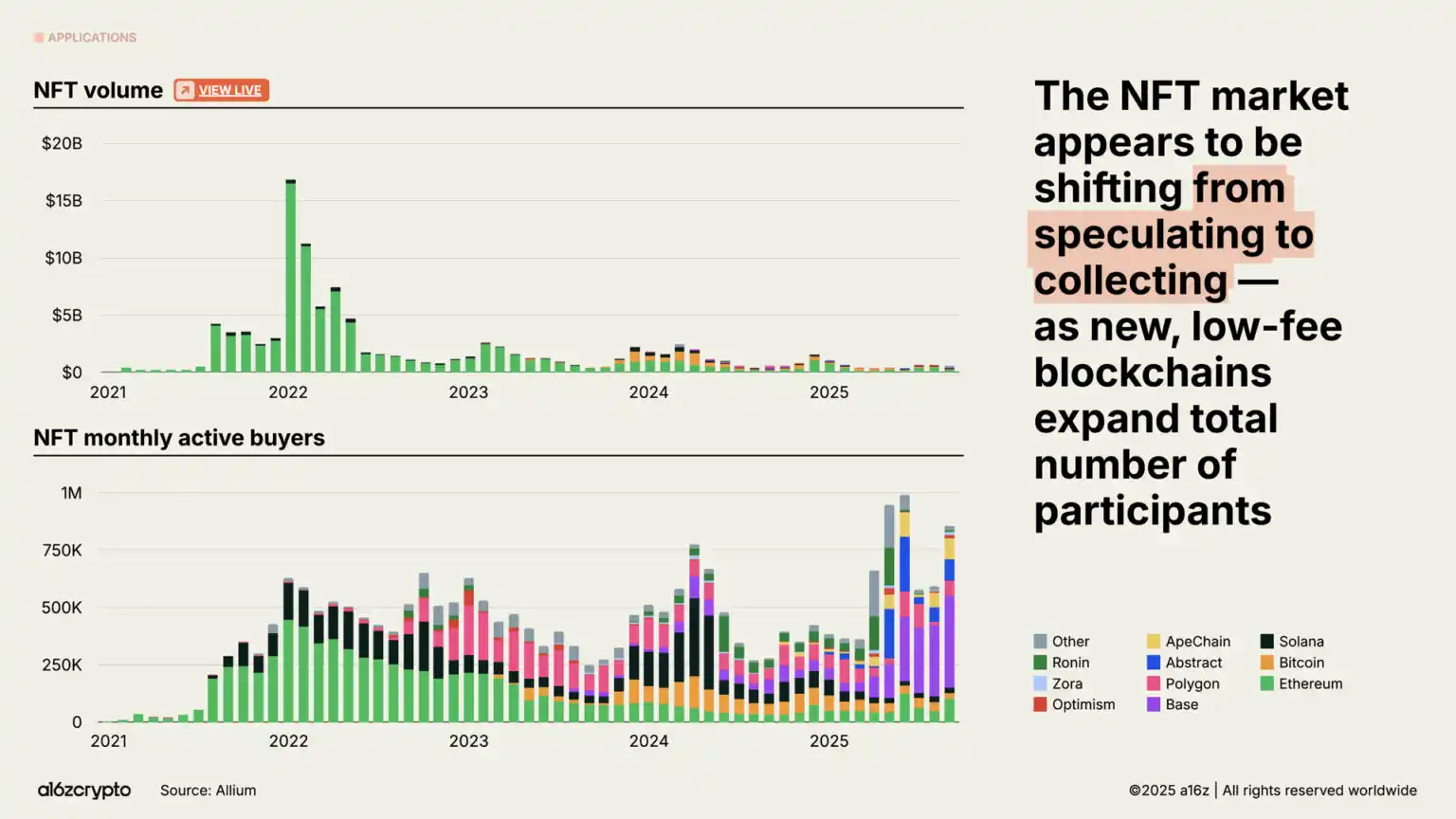
6. Blockchain Infrastructure Approaching Maturity Inflection Point
Without significant advances in blockchain infrastructure, none of these activities would be possible.
In just five years, the total transaction throughput of mainstream blockchain networks has grown over 100 times. The blockchain's transaction processing capacity per second has increased from less than 25 transactions to 3400 transactions per second, now on par with the Nasdaq transaction speed and Stripe's global processing volume during Black Friday, at a cost that is only a fraction of historical costs.
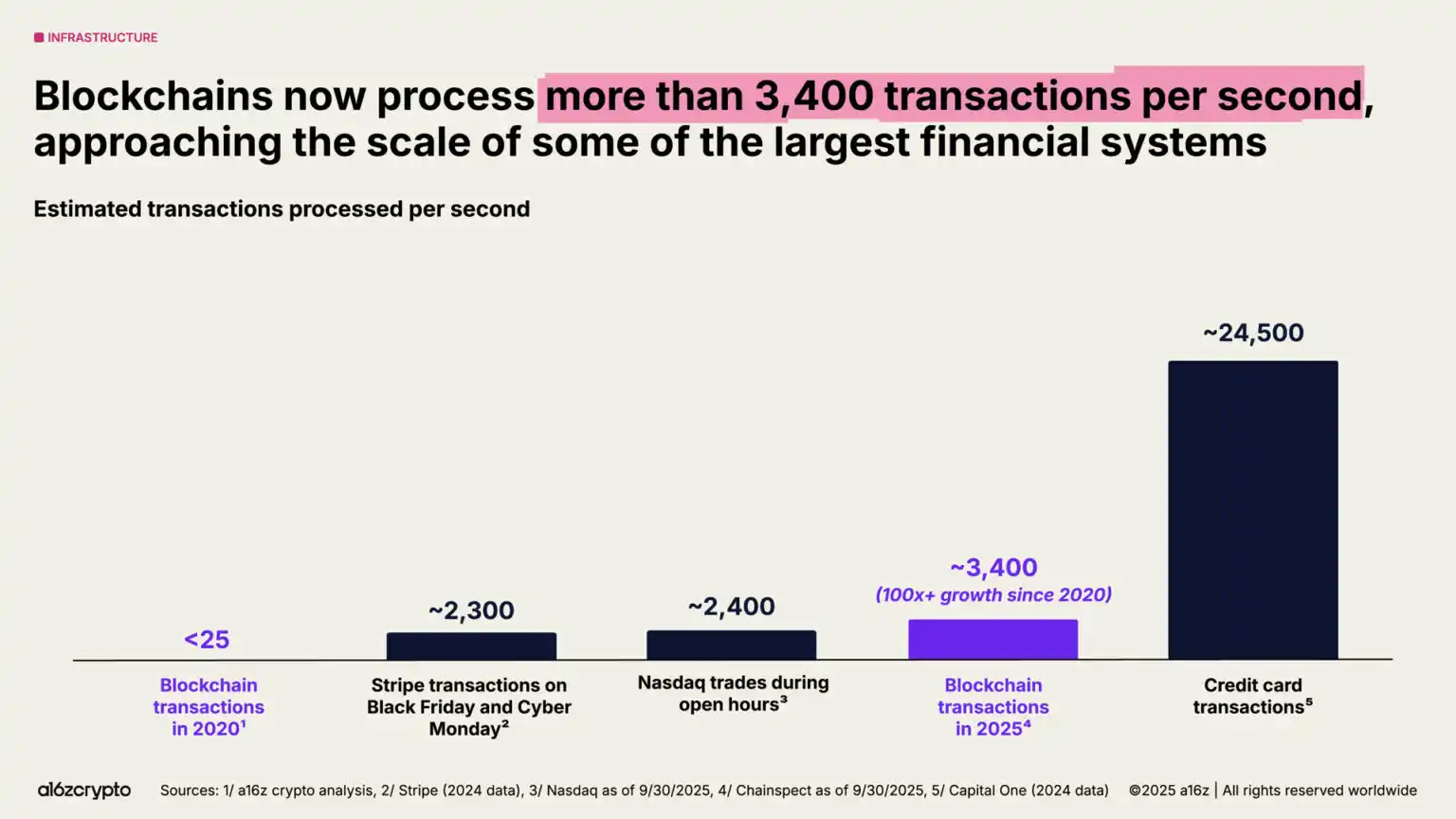
Within the blockchain ecosystem, Solana has become one of the most prominent representatives. Its high-performance, low-cost architecture now supports various applications from the DePIN project to the NFT market, with its native apps generating $3 billion in revenue over the past year. Planned upgrades are expected to double the network's capacity by the end of the year.
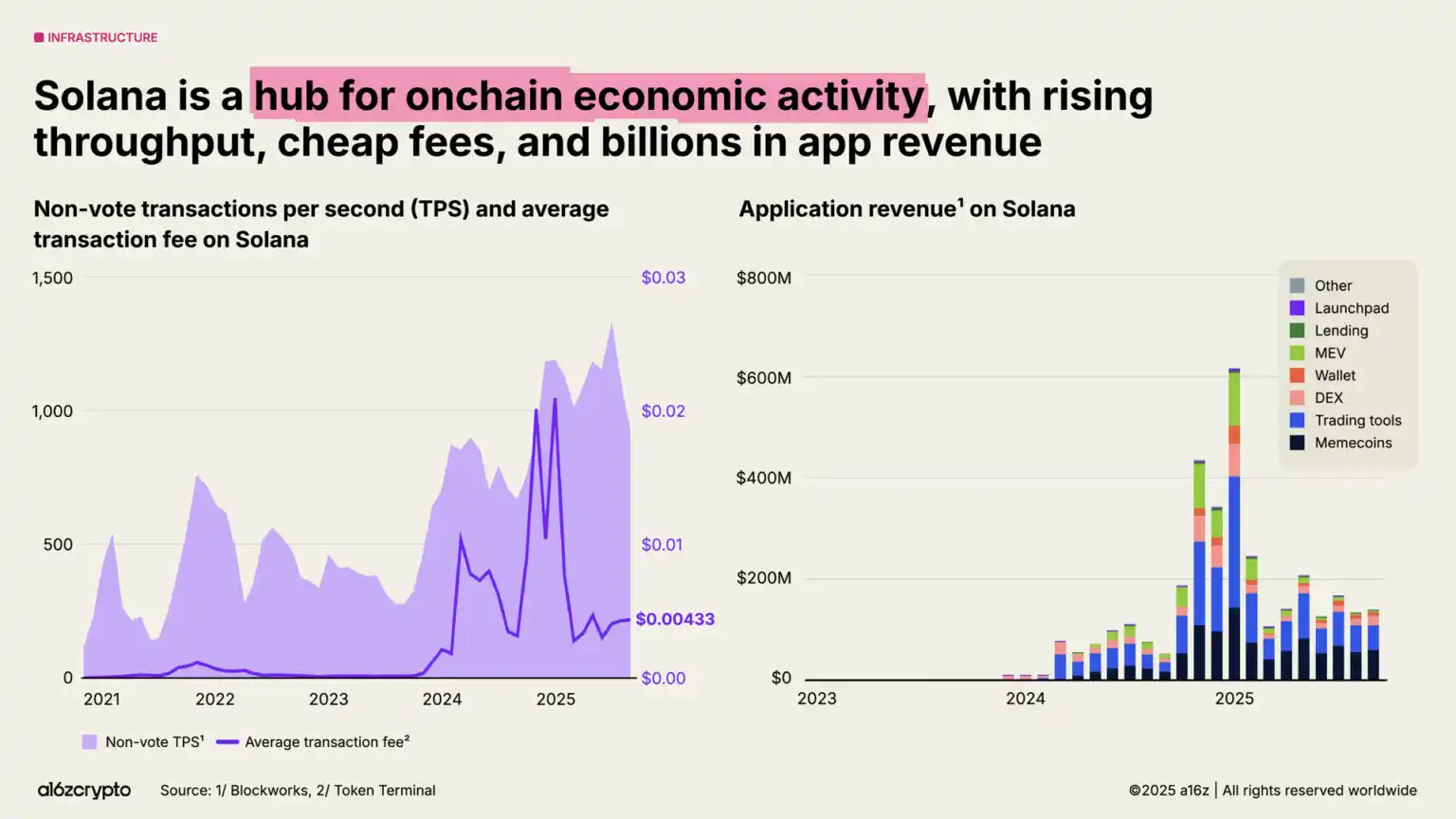
Ethereum continues to advance its scaling roadmap, with most economic activity migrated to second-layer solutions such as Arbitrum, Base, and Optimism. The average transaction cost on L2 has decreased from around $24 in 2021 to less than one cent today, making Ethereum-related block space both cheap and abundant.
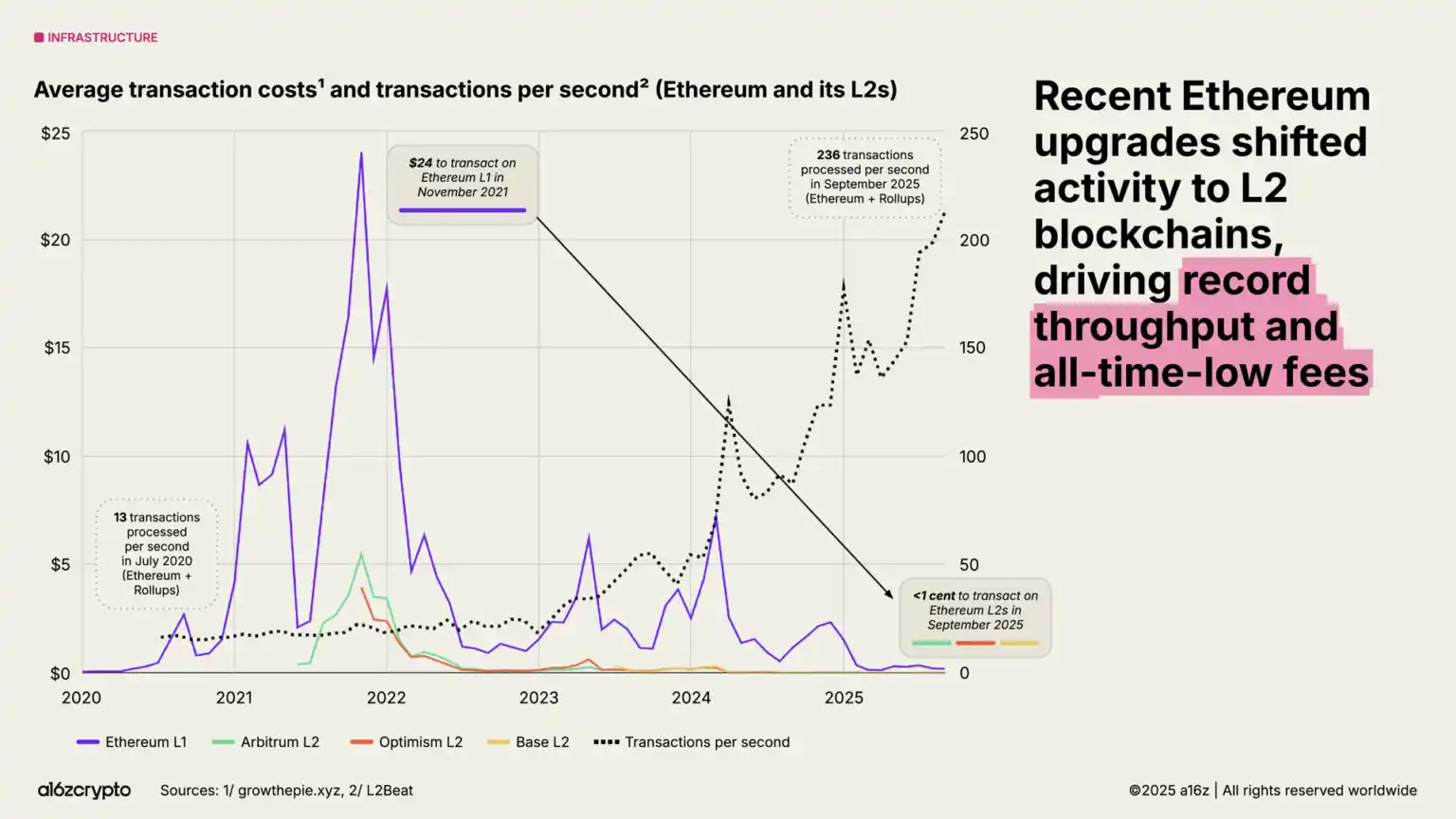
Cross-chain bridges are now achieving blockchain interoperability. Solutions like LayerZero and Circle's cross-chain transfer protocol allow users to transfer assets across multi-chain systems. The Hyperliquid bridge has seen a transaction volume of $74 billion since the beginning of the year.
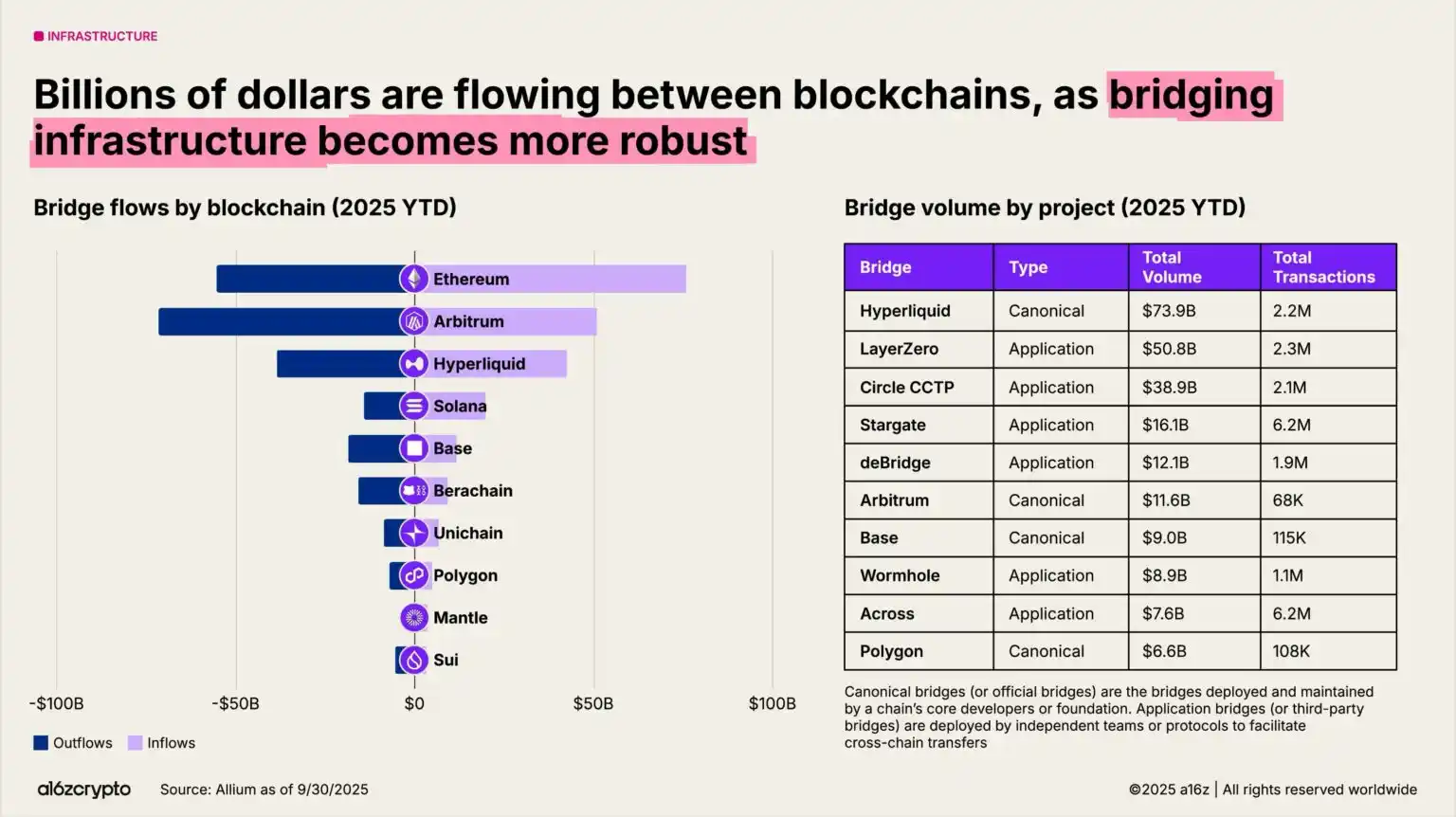
Privacy protection is returning to the forefront and may become a prerequisite for widespread applications. Signs of increased attention include a surge in Google searches related to crypto privacy in 2025; Zcash's shielded fund pool supply growing to nearly 4 million ZEC; and Railgun's monthly transaction volume surpassing $200 million.
More Signs of Development Momentum: Ethereum Foundation has established a new Privacy Team; Paxos collaborates with Aleo to launch a private and compliant stablecoin (USAD); the Office of Foreign Asset Control has lifted sanctions on the decentralized privacy protocol Tornado Cash. We expect that as cryptographic technology continues to mainstream, this trend will gain further momentum in the coming years.
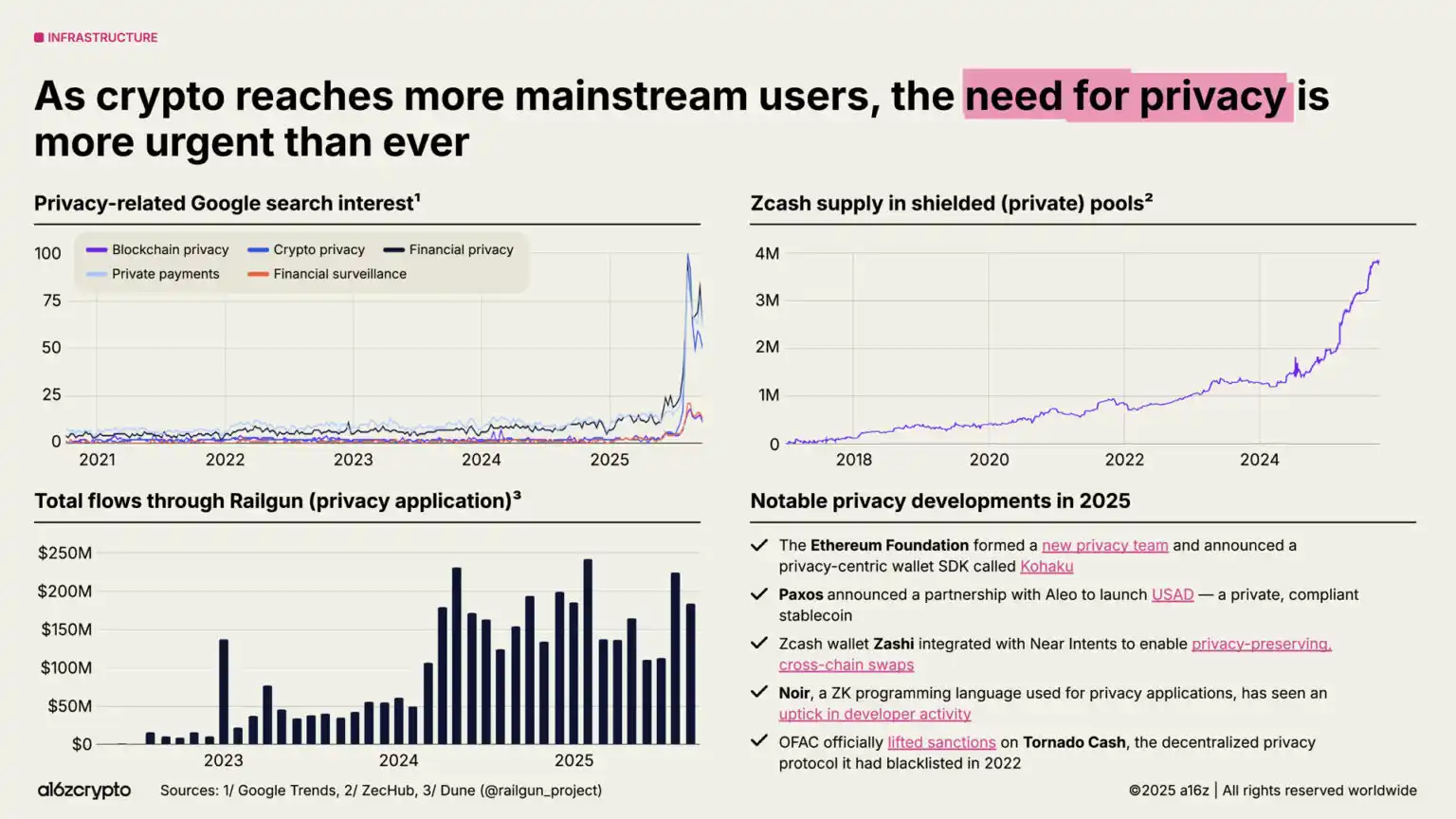
Likewise, zero-knowledge proofs and succinct proof systems are rapidly evolving from decades of academic research into critical infrastructure. Zero-knowledge systems are now integrated into Rollups, compliance tools, and even mainstream web services—a prime example being Google's newly launched ZK identity system.
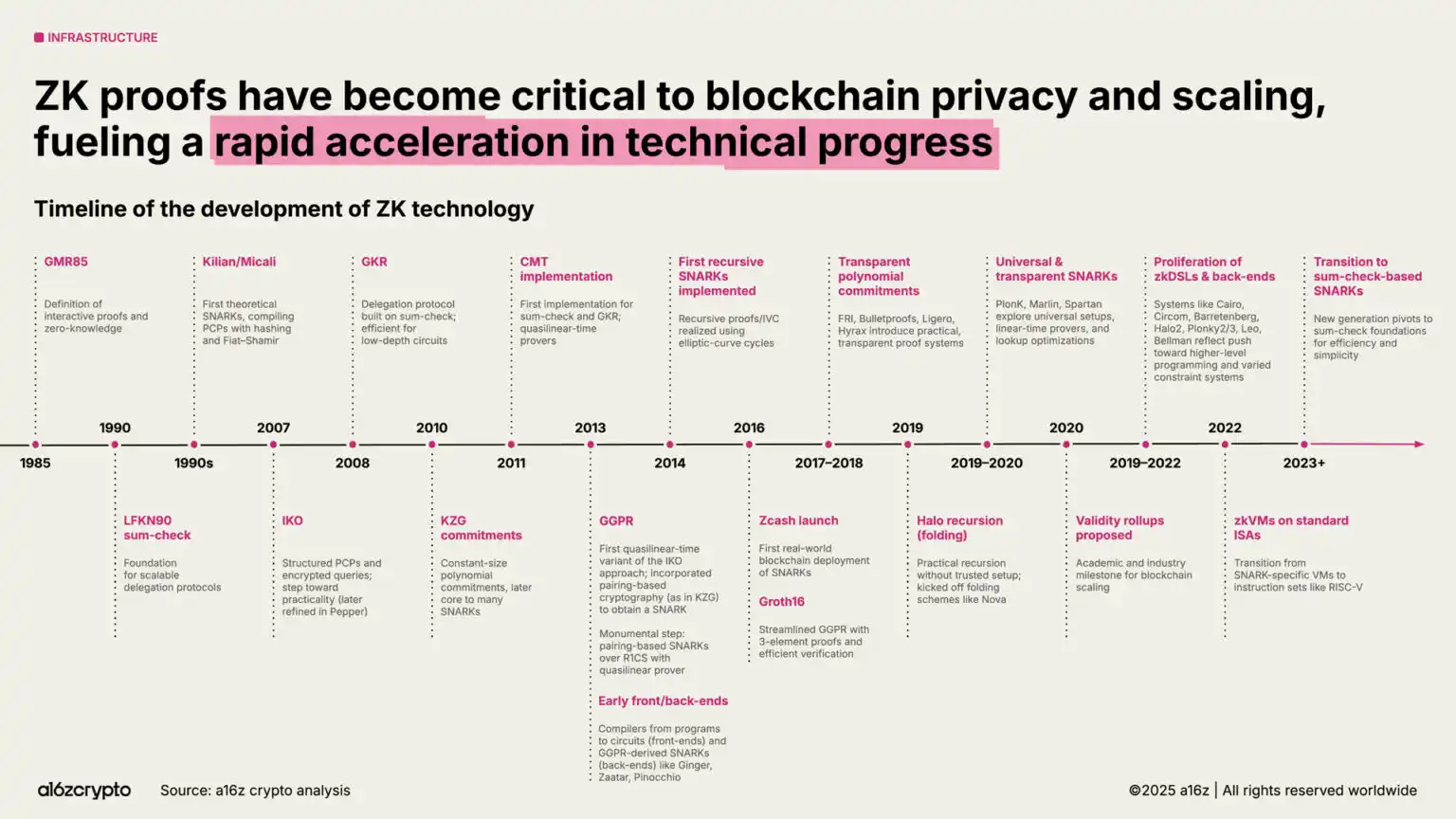
Meanwhile, blockchain is accelerating progress on the post-quantum computing roadmap. Currently, around $750 billion worth of Bitcoin is held in addresses vulnerable to future quantum attacks. The U.S. government plans to transition the federal systems to post-quantum cryptographic algorithms by 2035.
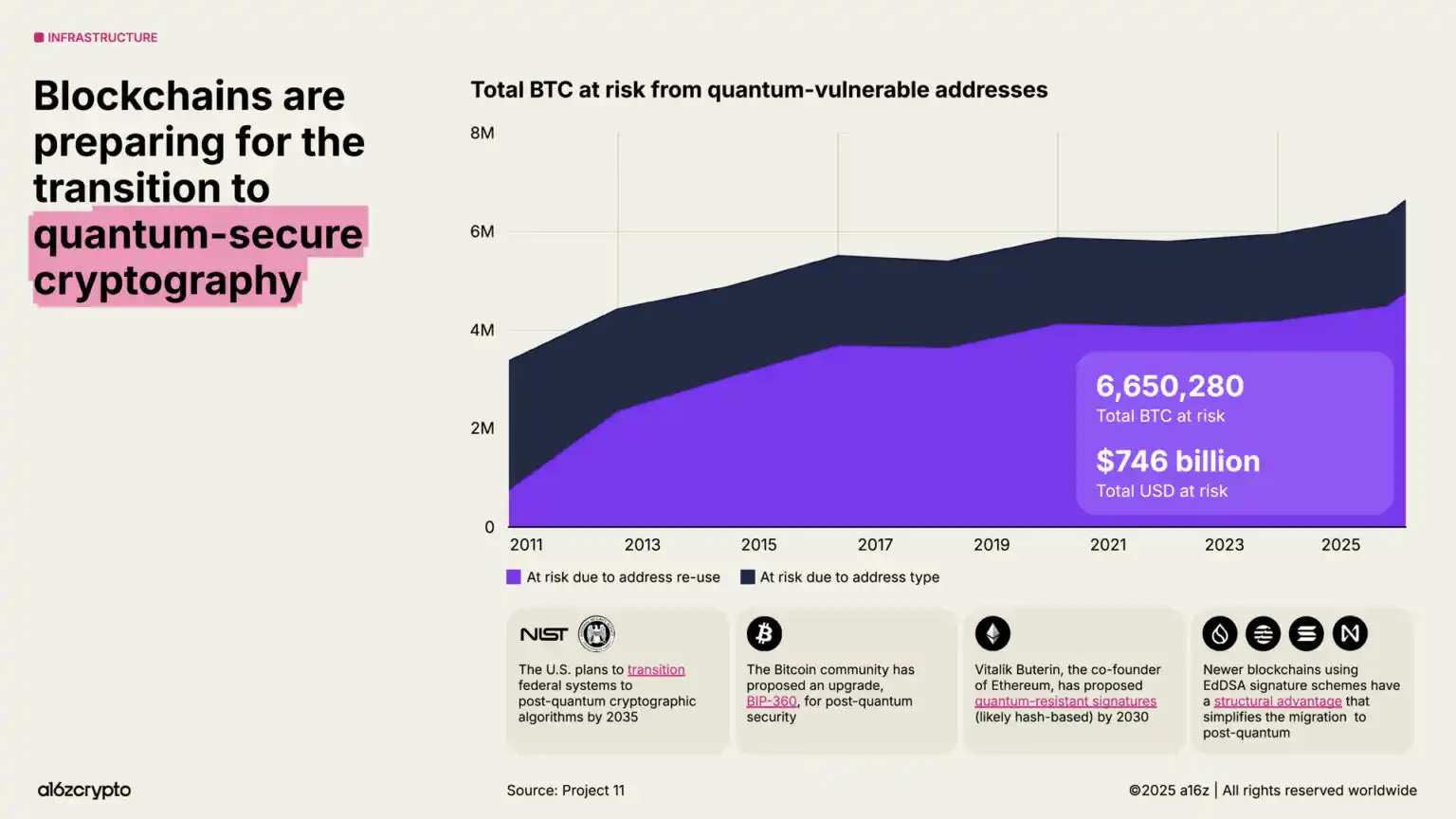
7. Deep Integration of Cryptography and Artificial Intelligence Technologies
Among many technological advances, the launch of ChatGPT in 2022 has brought AI into the public spotlight—also presenting clear opportunities for the encryption field. From traceability and IP licensing to providing payment channels for intelligent agents, cryptographic technology could be the answer to addressing the most pressing challenges in the AI domain.
Decentralized identity systems like Worldcoin, which have already verified over 17 million users, can provide "human-proof" and help distinguish real users from bots.
Emerging protocol standards such as x402 are becoming potential financial infrastructure for autonomous AI agents, aiding them in microtransactions, API calls, and intermediary-free settlements—Gartner predicts that such an economy could reach $30 trillion by 2030.
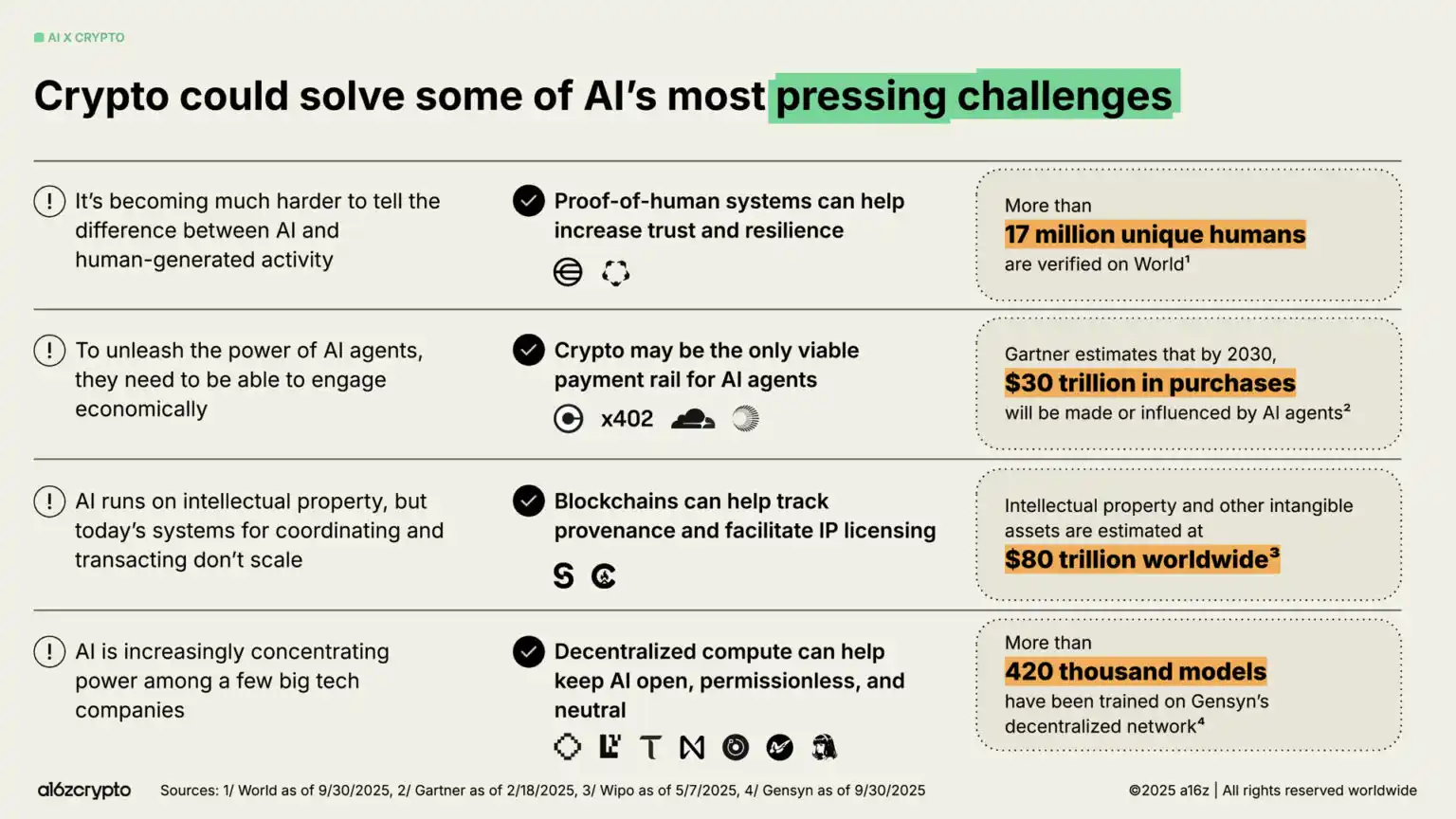
Meanwhile, the computational layer of artificial intelligence is consolidating around a few tech giants, raising concerns about centralization and scrutiny. Currently, only two companies, OpenAI and Anthropic, control 88% of "AI-native" enterprise revenue, Amazon, Microsoft, and Google occupy 63% of the cloud infrastructure market share, and Nvidia holds a 94% share of the data center GPU market. This imbalance has enabled the "Big Seven" companies to achieve double-digit net profit growth for several quarters, while the remaining 493 companies in the S&P 500 have generally failed to outperform inflation.
The blockchain technology provides a counterbalance to the centralizing forces that AI systems exhibit.
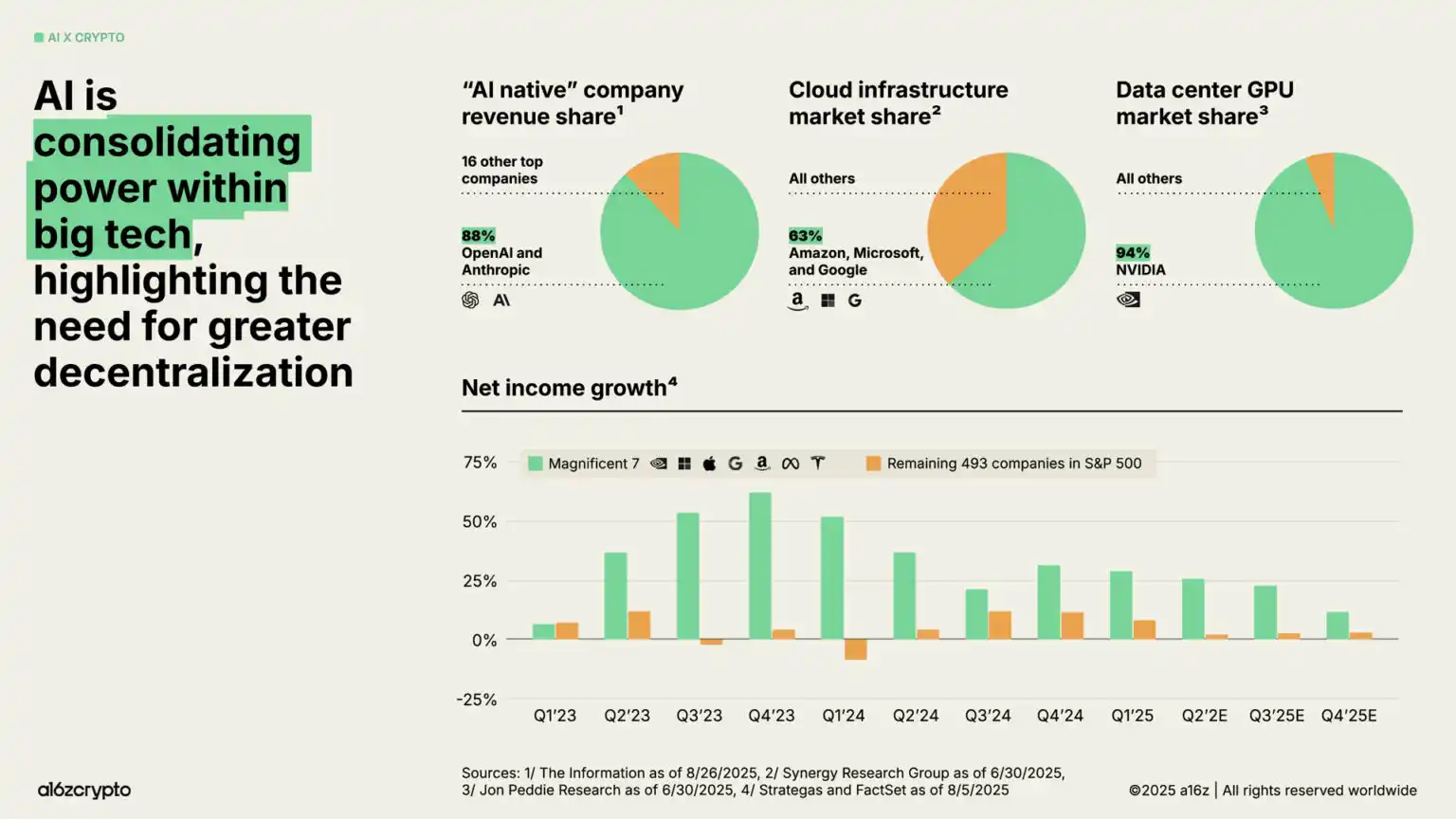
Within the AI hype, some crypto builders have shifted their focus. Our analysis shows that around 1000 roles have moved from the crypto industry to the AI field since the release of ChatGPT. However, this loss has been offset by an equal number of builders joining the crypto industry from traditional finance, tech, and other sectors.
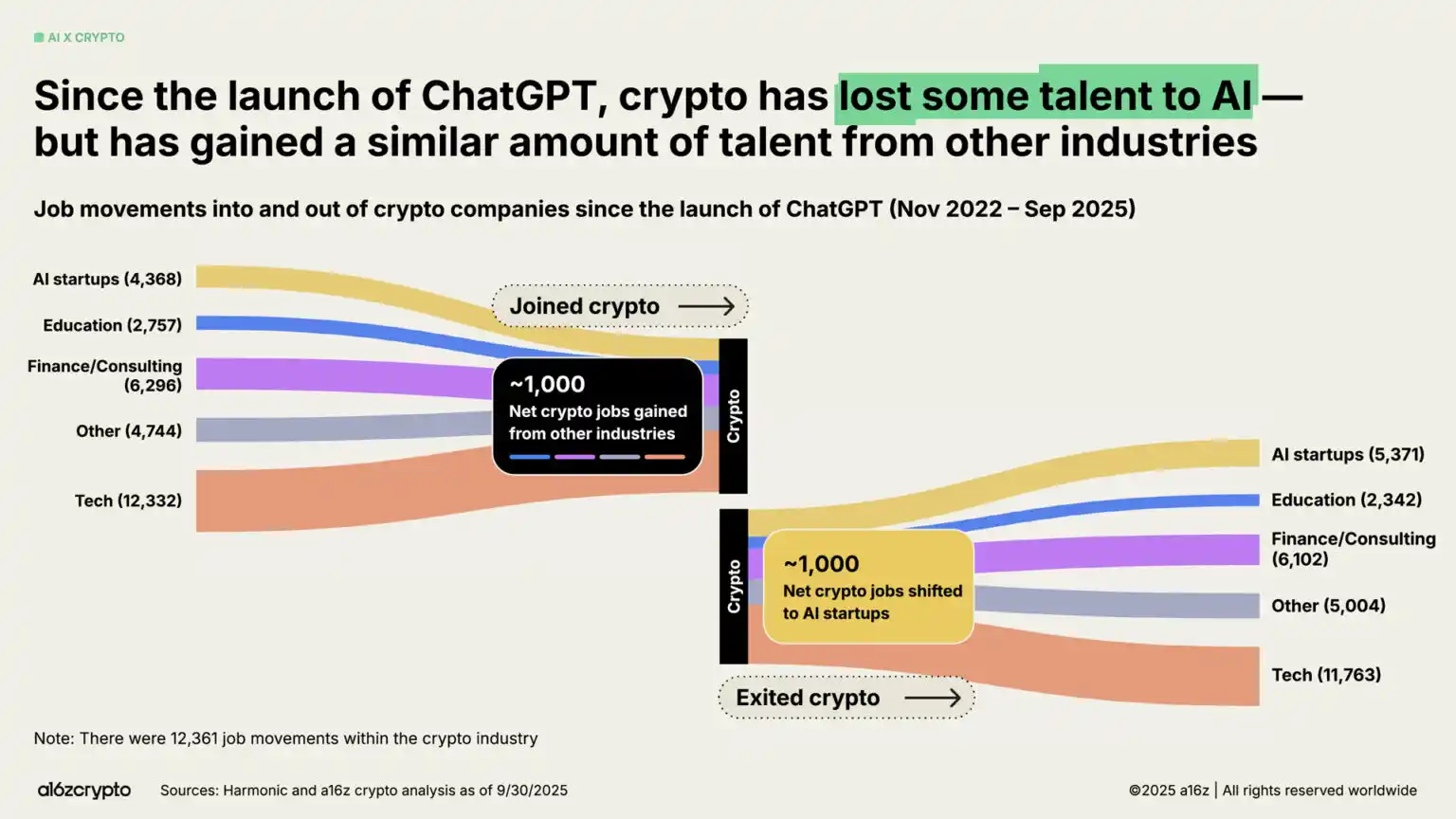
8. Future Outlook
Where are we currently positioned? With regulatory frameworks becoming clearer, the path for tokens to generate real income through fees is becoming evident. The adoption of crypto by traditional finance and fintech will continue to accelerate; stablecoins will upgrade the traditional financial system and drive global financial inclusion; new products will lead the next wave of users into the on-chain world.
We now have the infrastructure and distribution networks in place and are poised to soon gain regulatory certainty to drive the mainstreaming of the technology. It is now the moment to upgrade the financial system, rebuild global payment channels, and shape the ideal form of the internet.
The crypto industry, after seventeen years of development, is bidding farewell to its adolescence and entering maturity.
Disclaimer: The content of this article solely reflects the author's opinion and does not represent the platform in any capacity. This article is not intended to serve as a reference for making investment decisions.
You may also like
Must Public Chains Embrace the Meme Trend?
The experience of Solana teaches us that "governments" should not direct the development of "enterprises."

Space Review|JST Buyback and Burn Plan Officially Launched, Ushering in a New Chapter for TRON DeFi Value
The large-scale JST buyback and burn plan has been launched, injecting protocol net income into a deflationary model to build a sustainable "value flywheel."
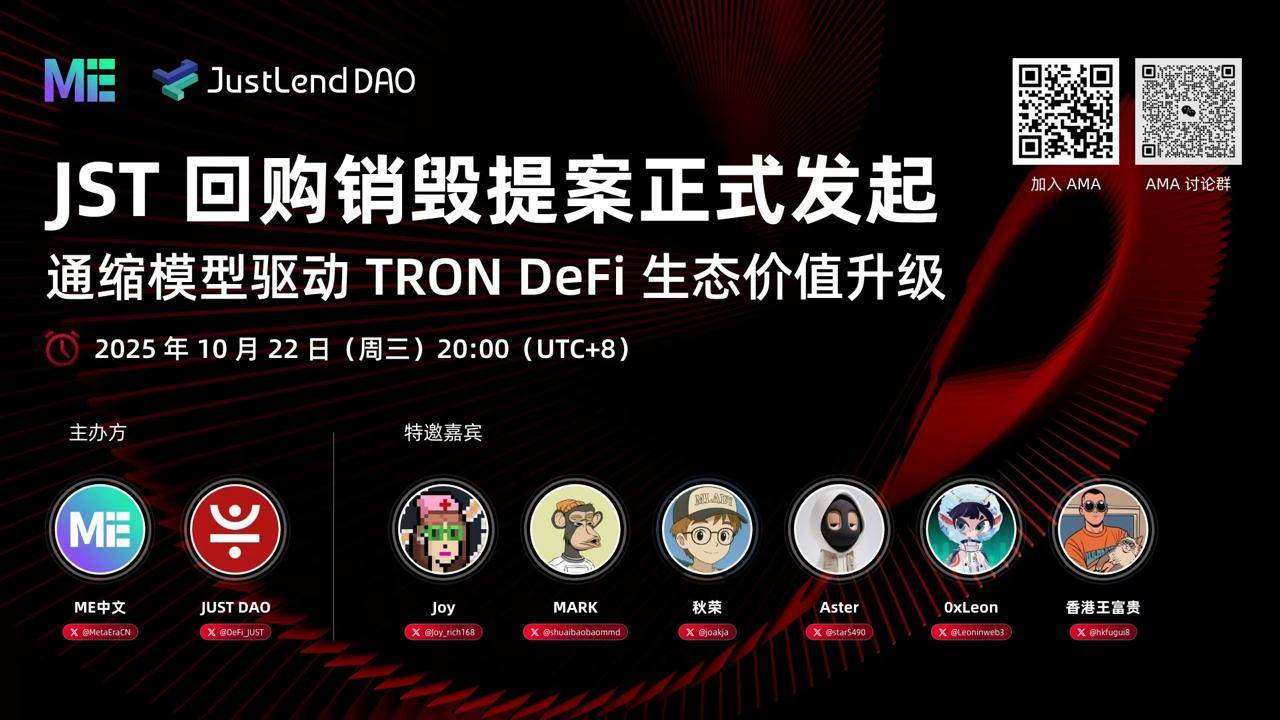
Virtuals Robotics: Why Did We Enter the Field of Embodied Intelligence?
Digital intelligence acquires physical entities, integrating thought and action in the field of robotics.

The EU imposes sanctions on the stablecoin A7A5 pegged to the Russian ruble.
